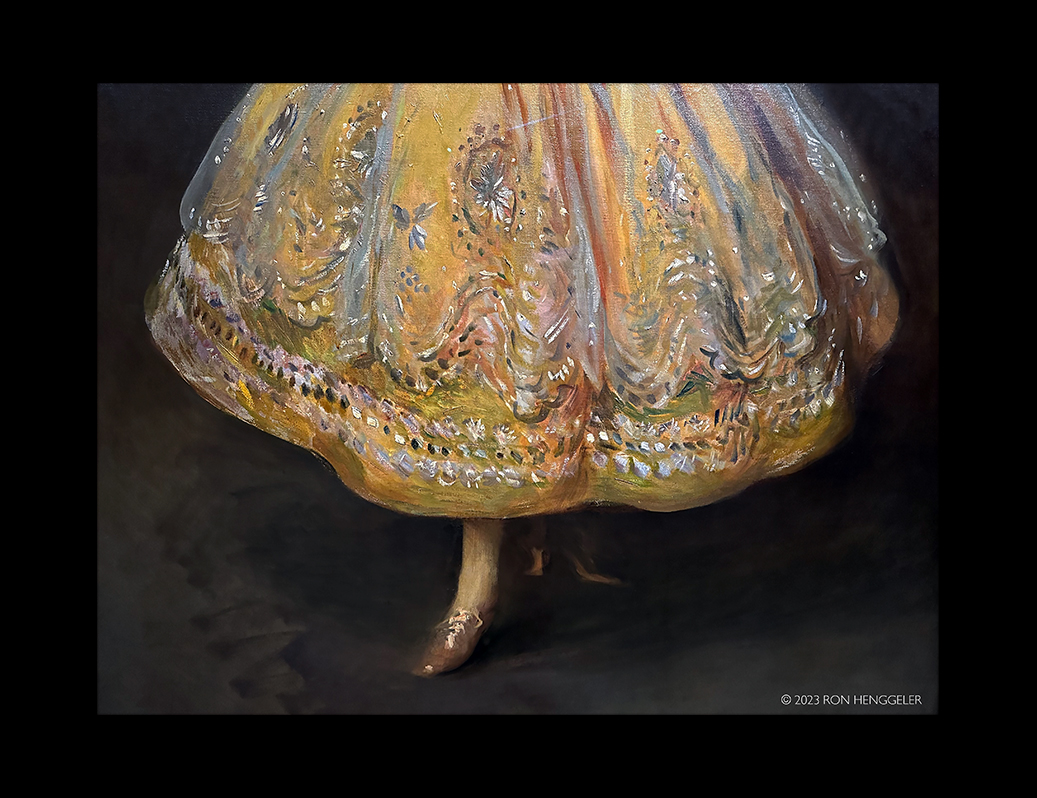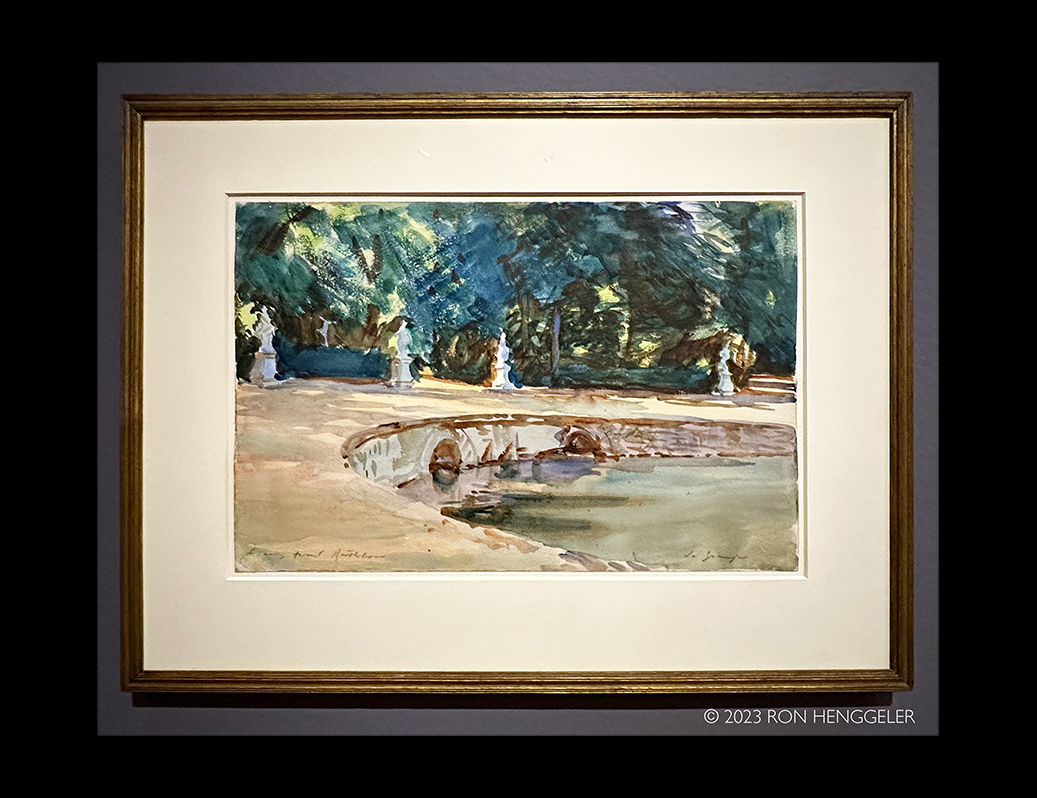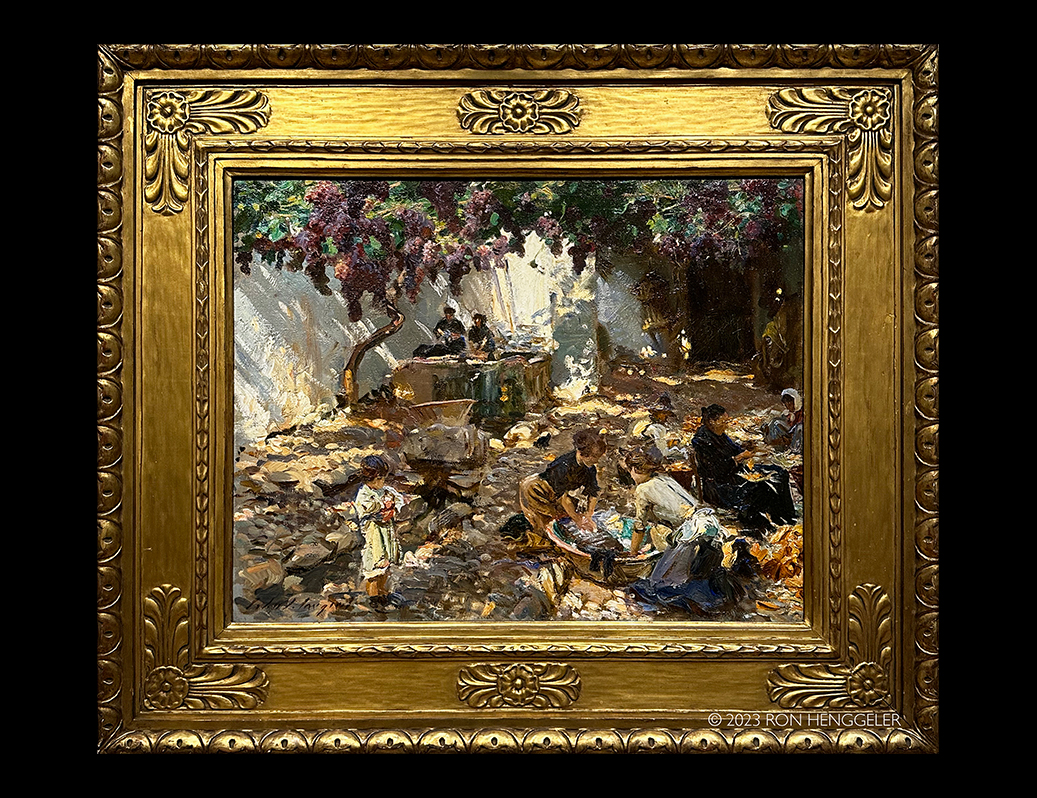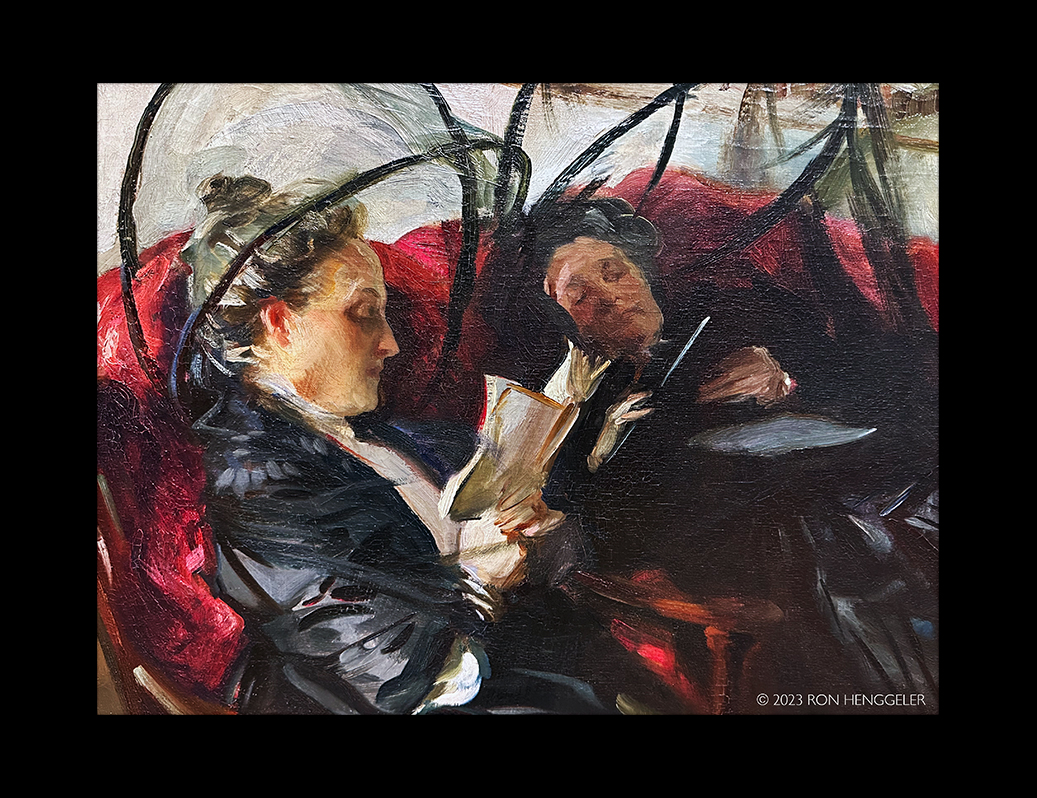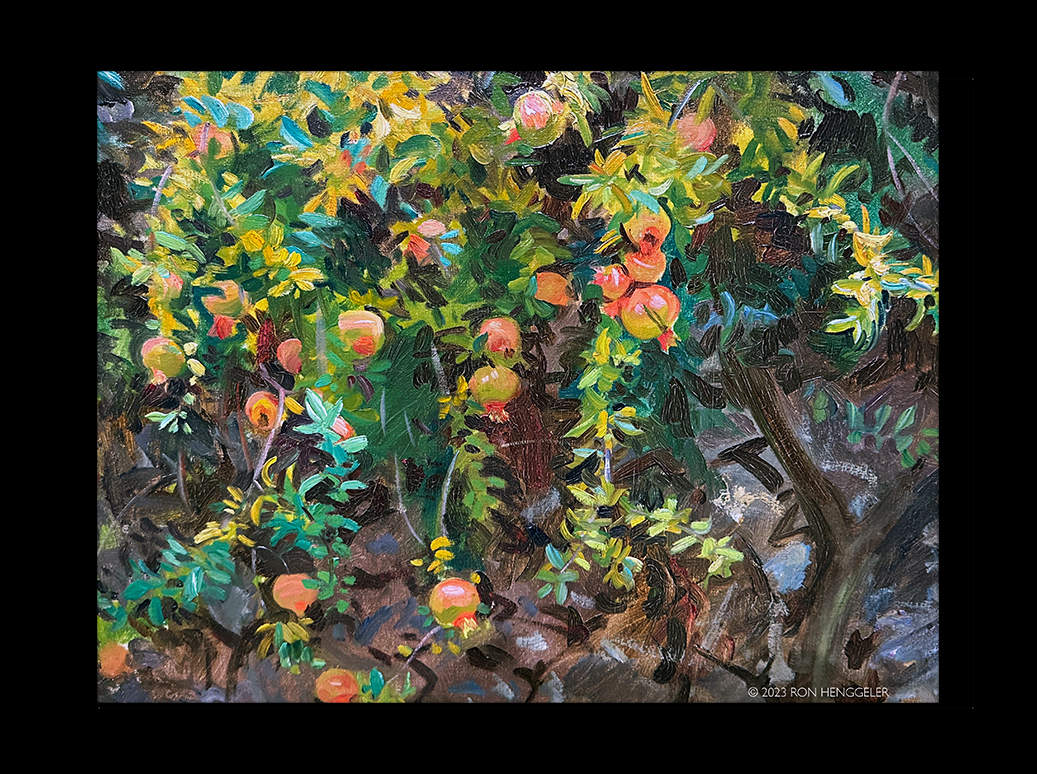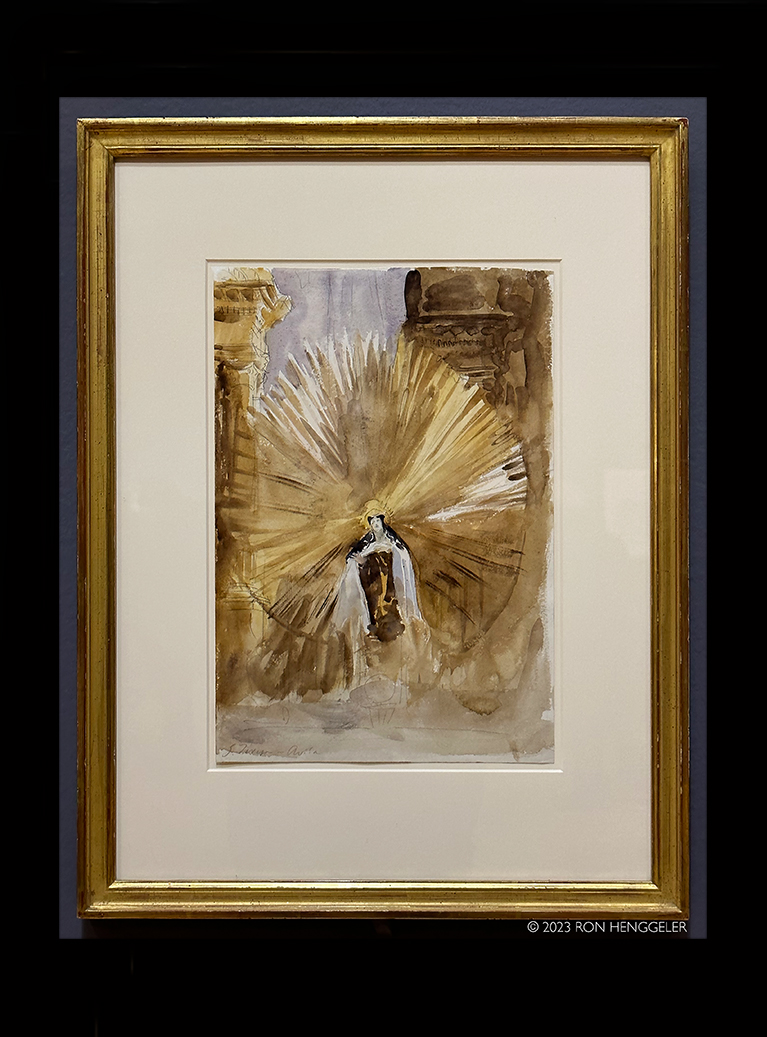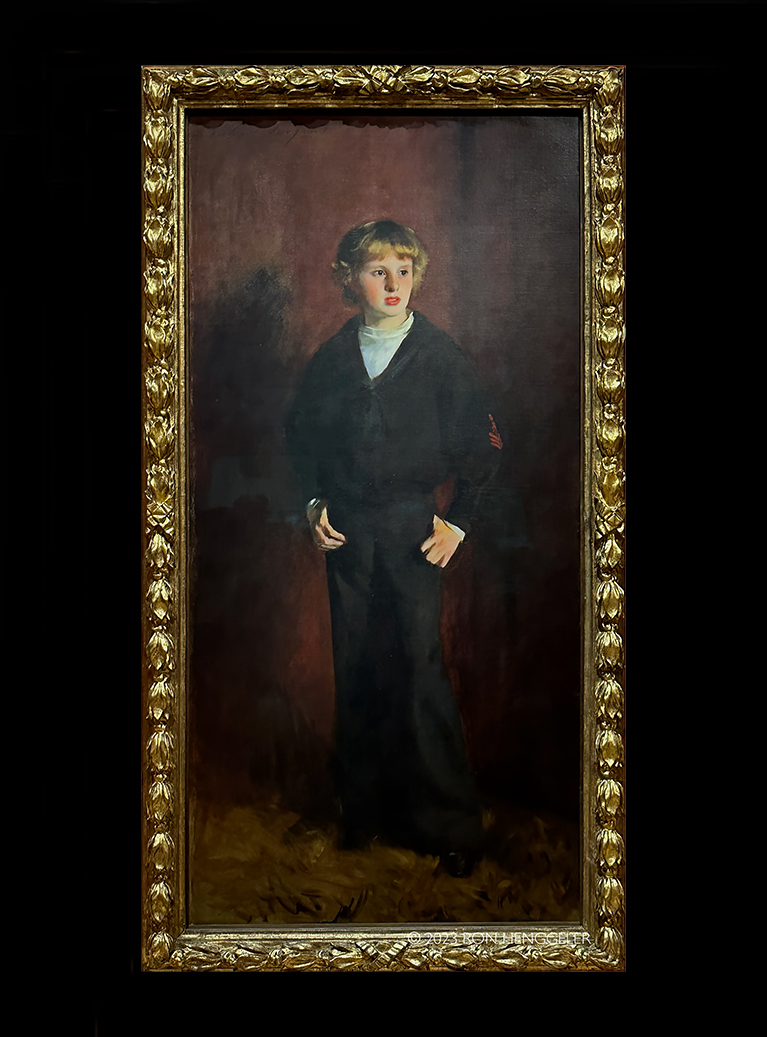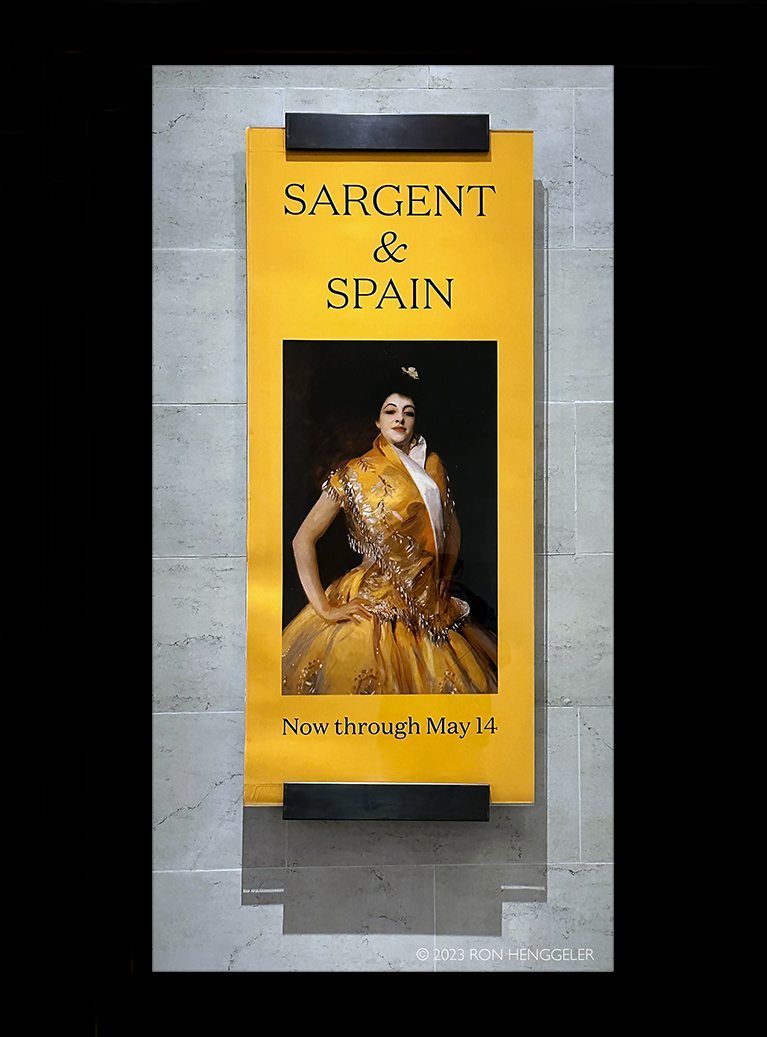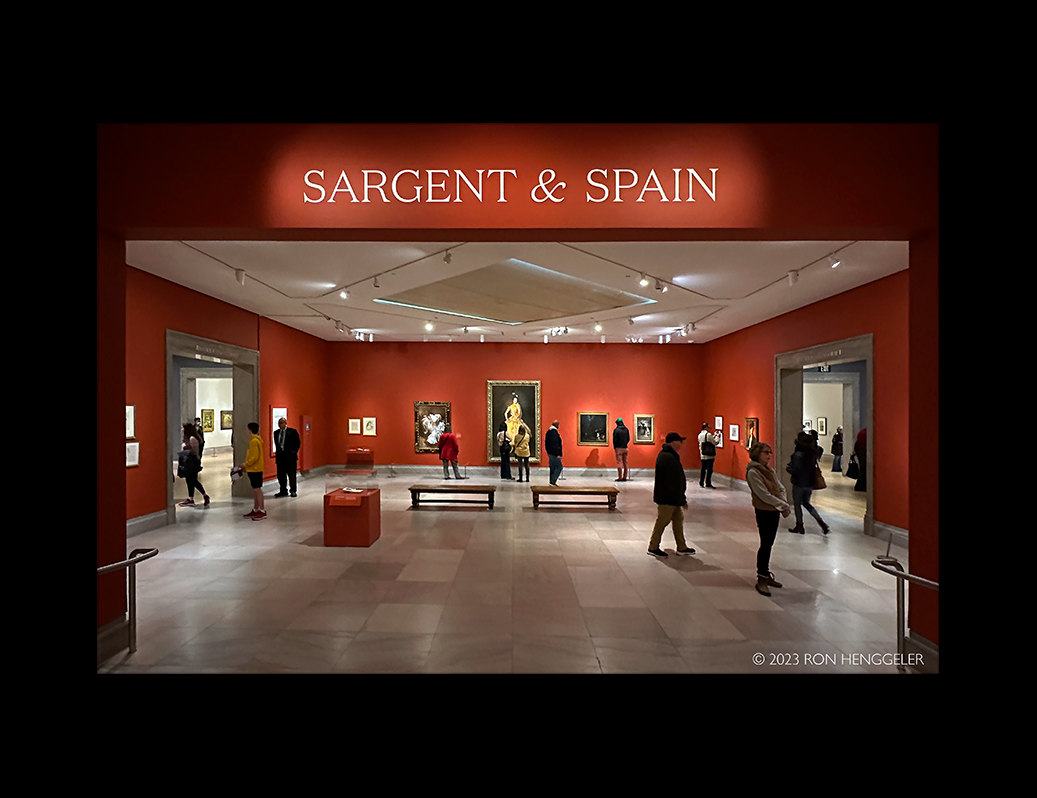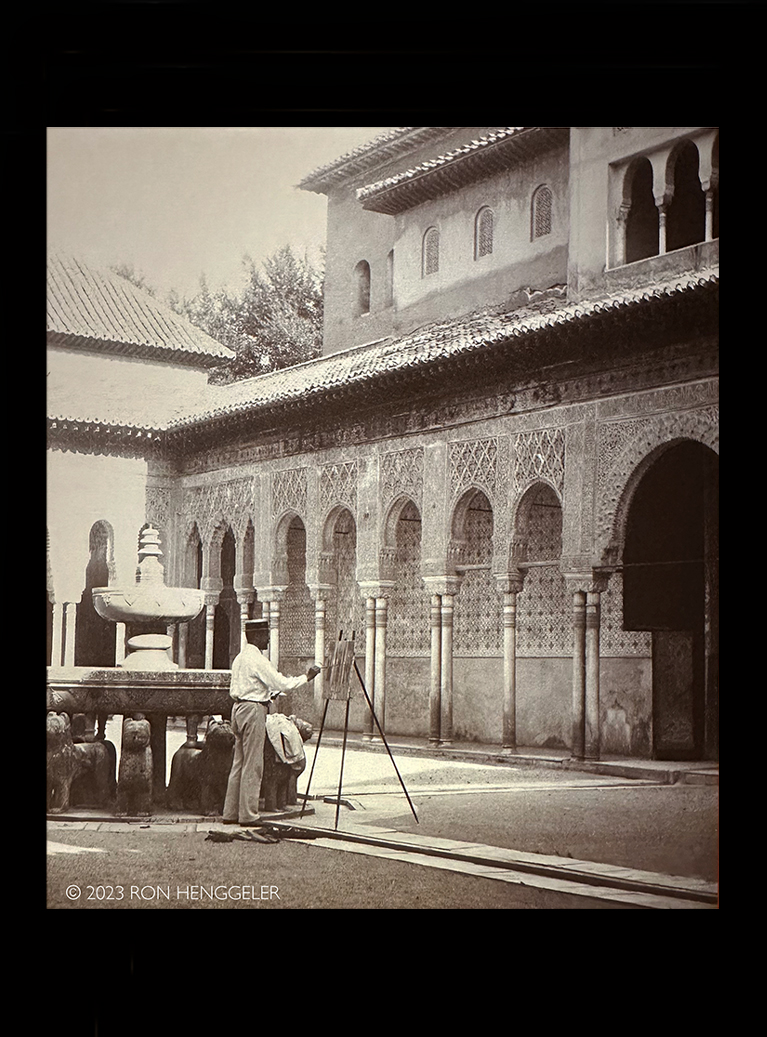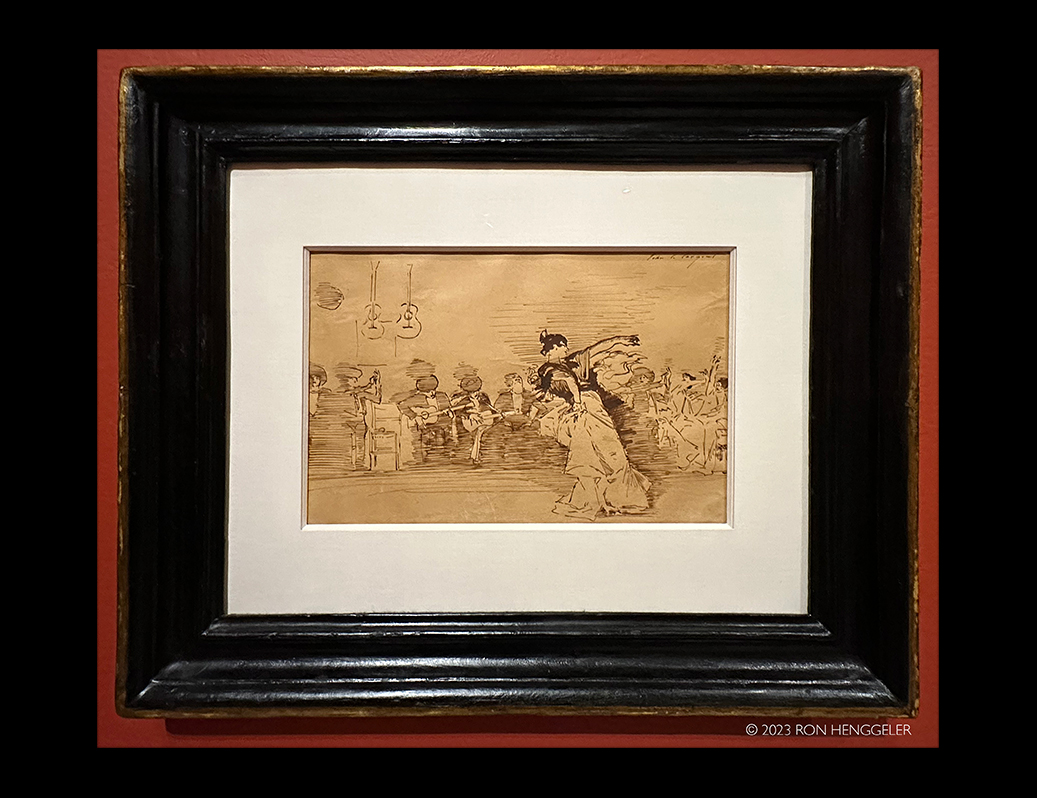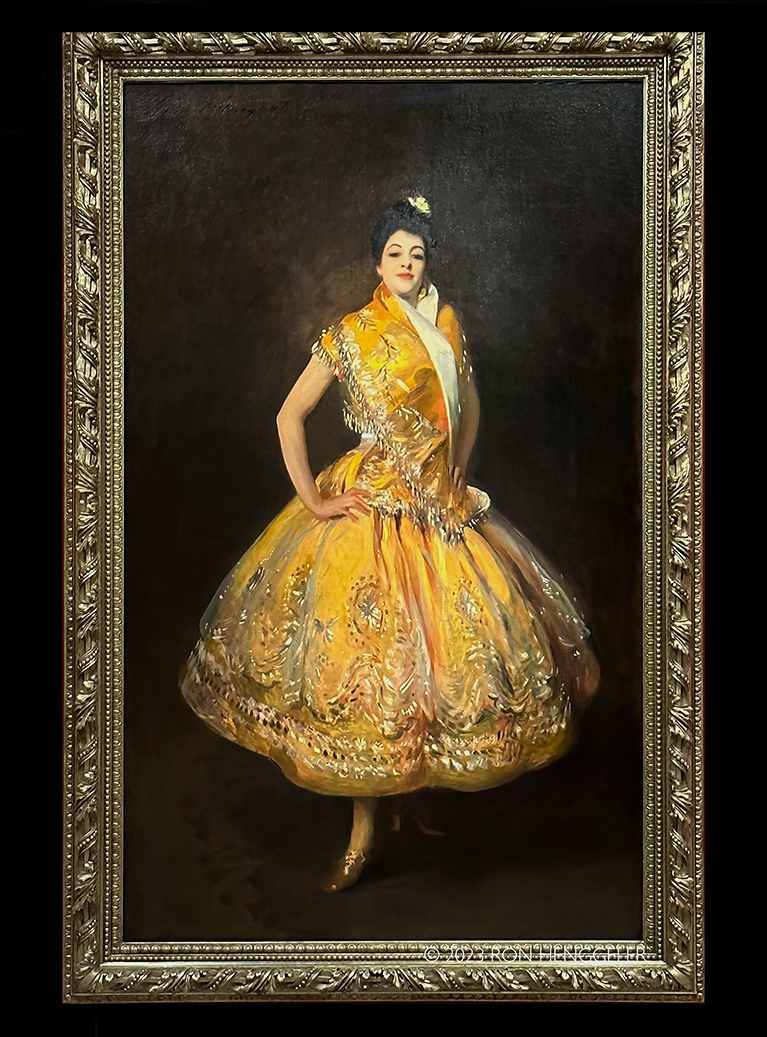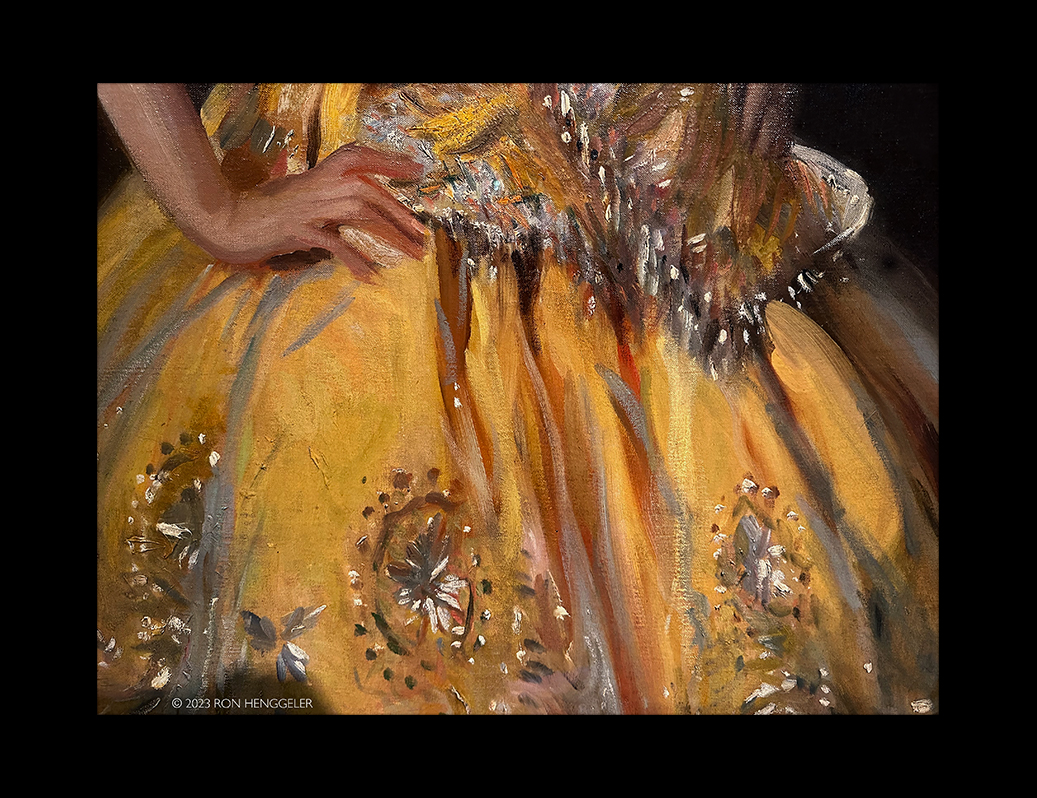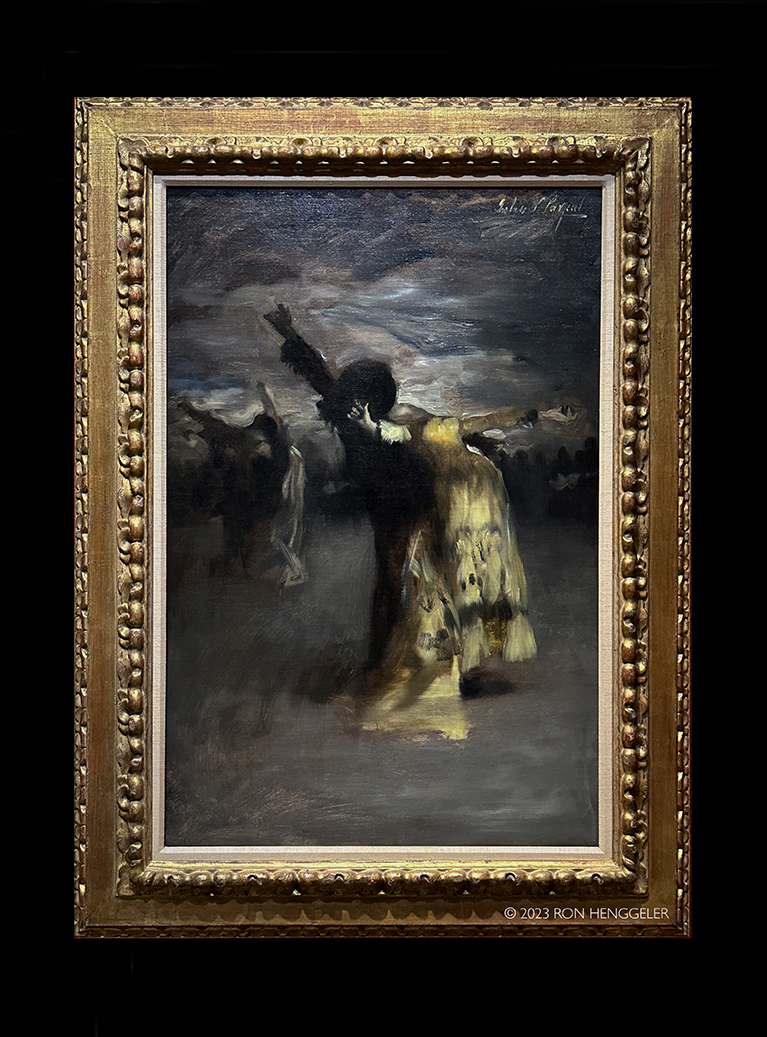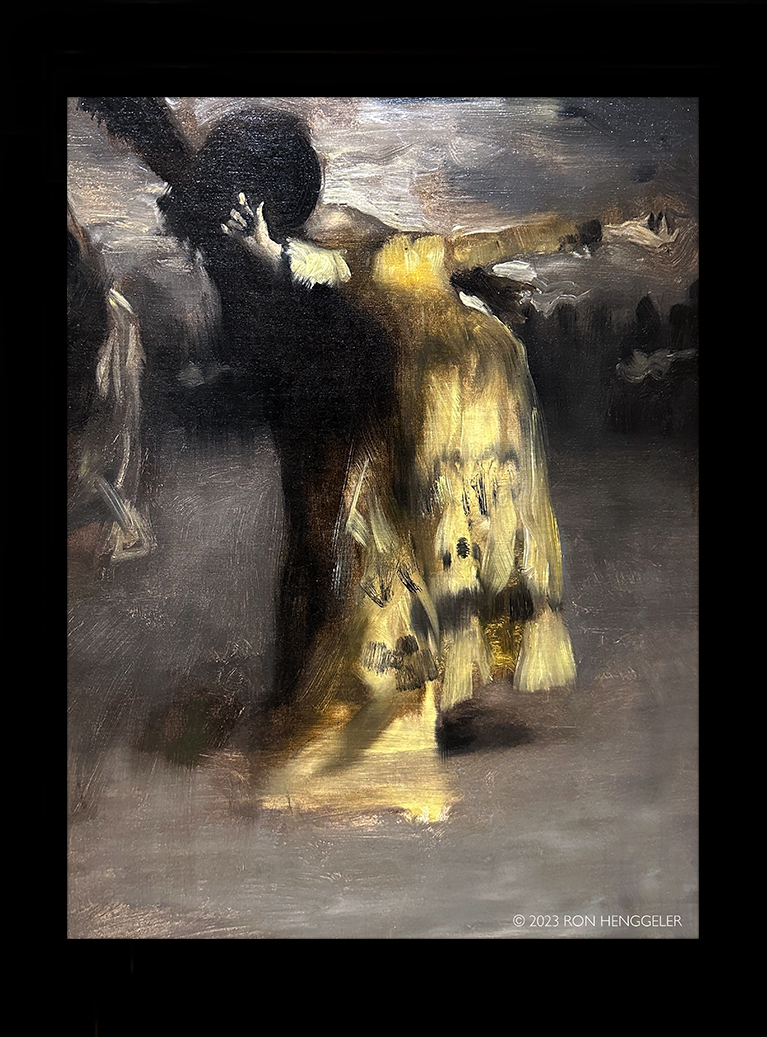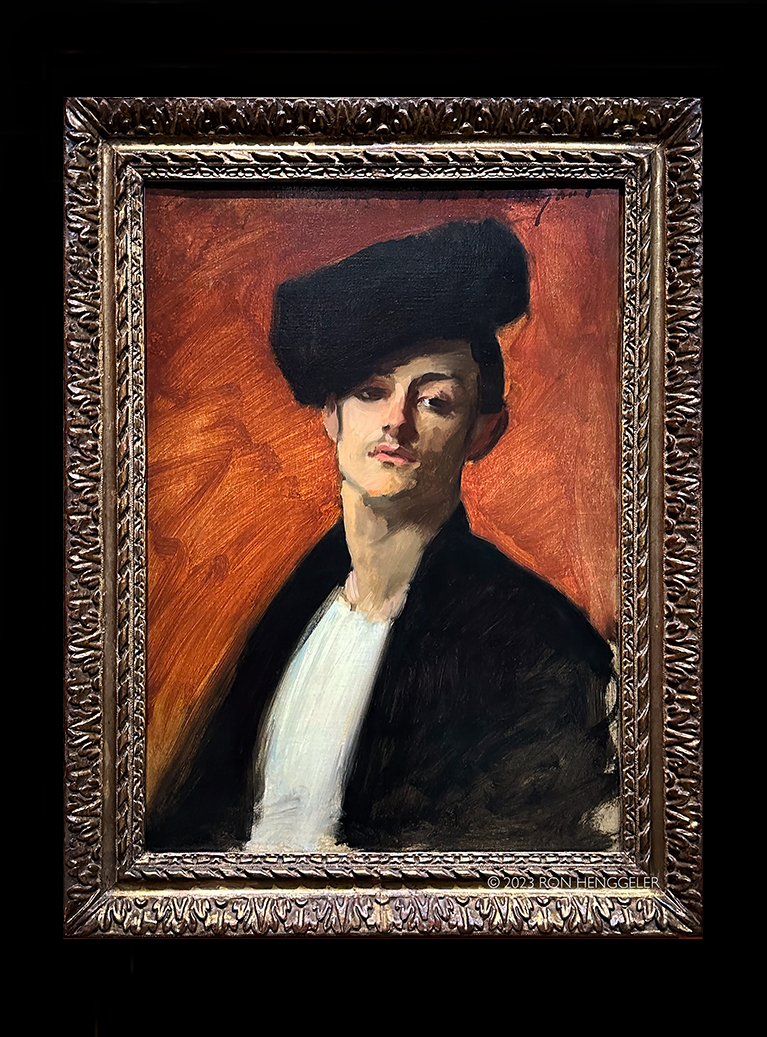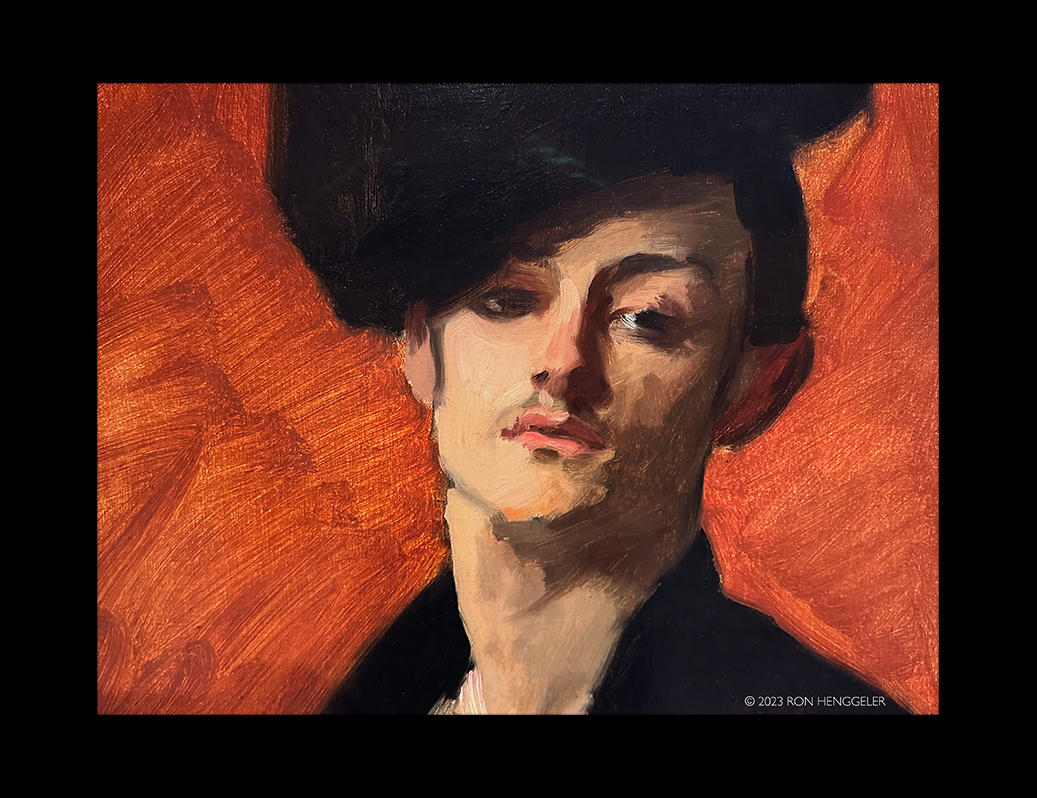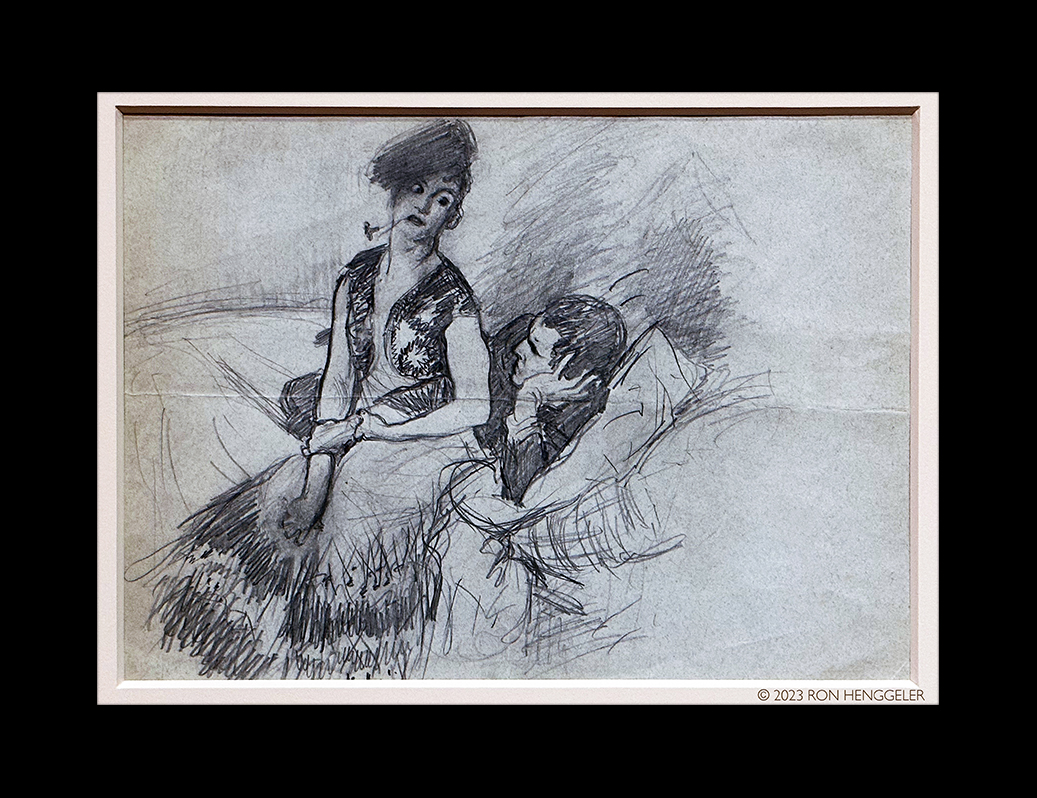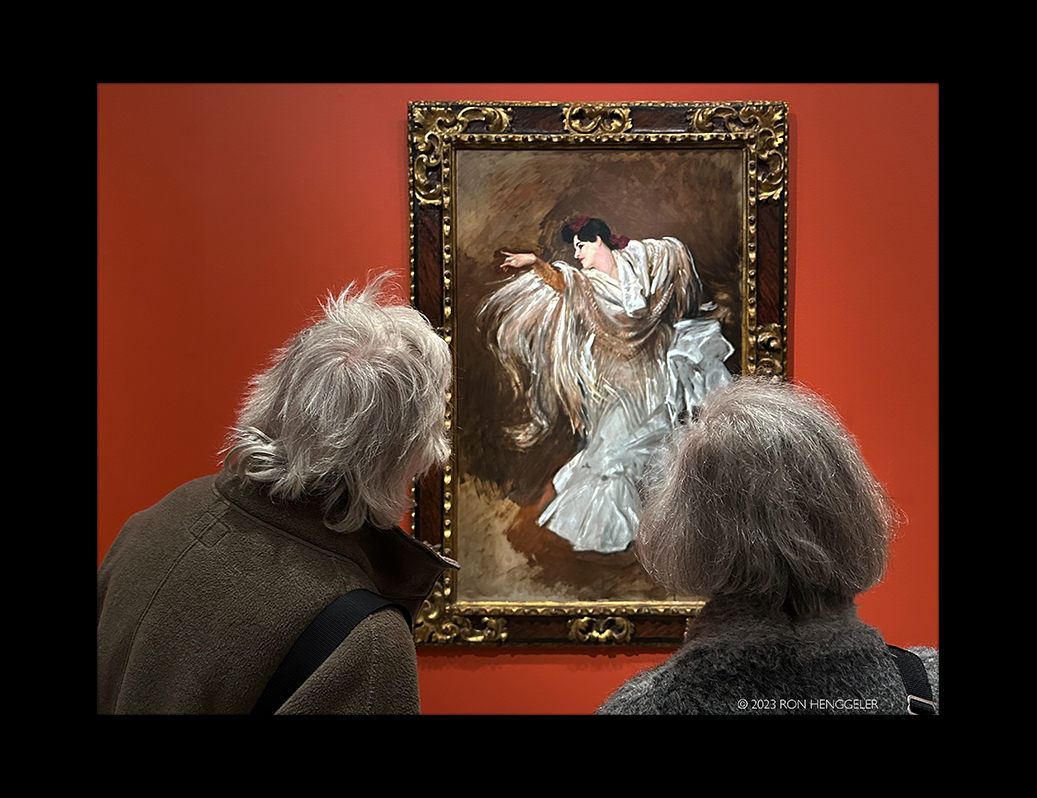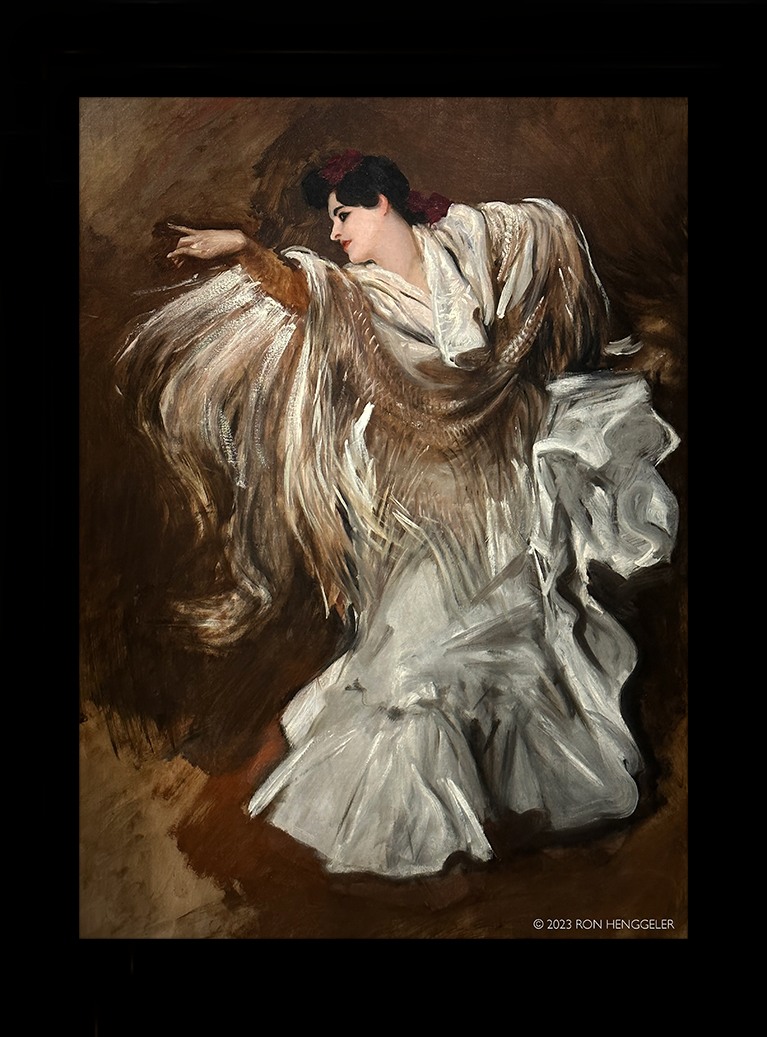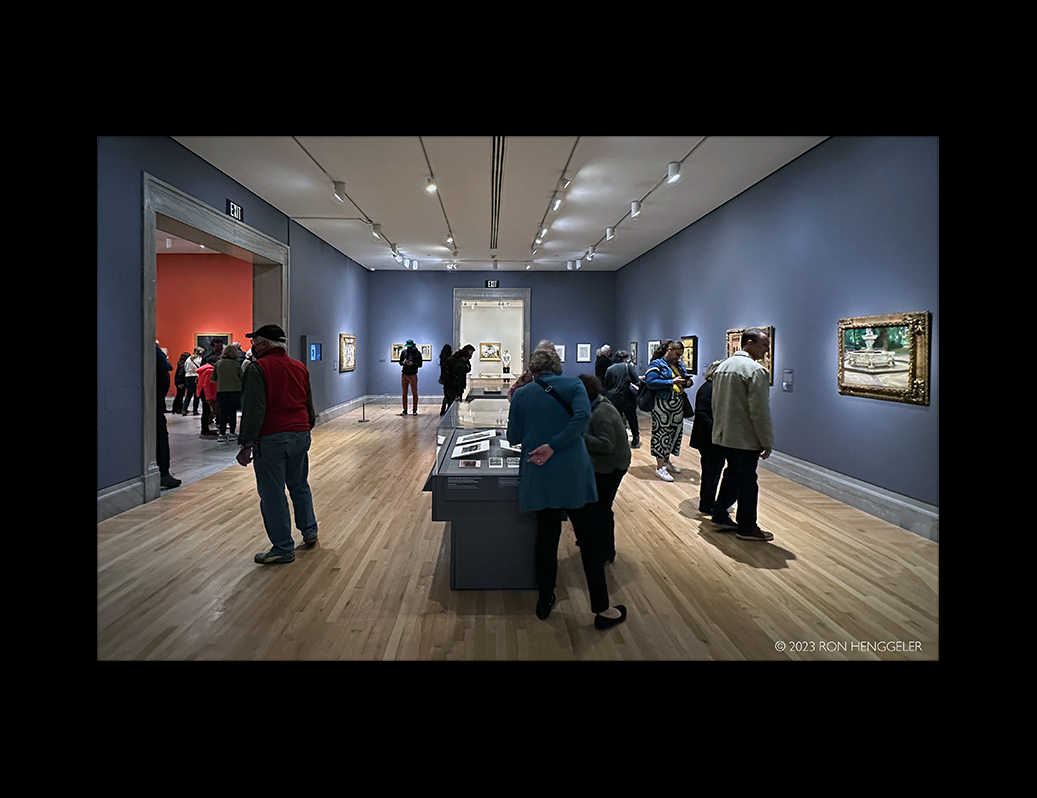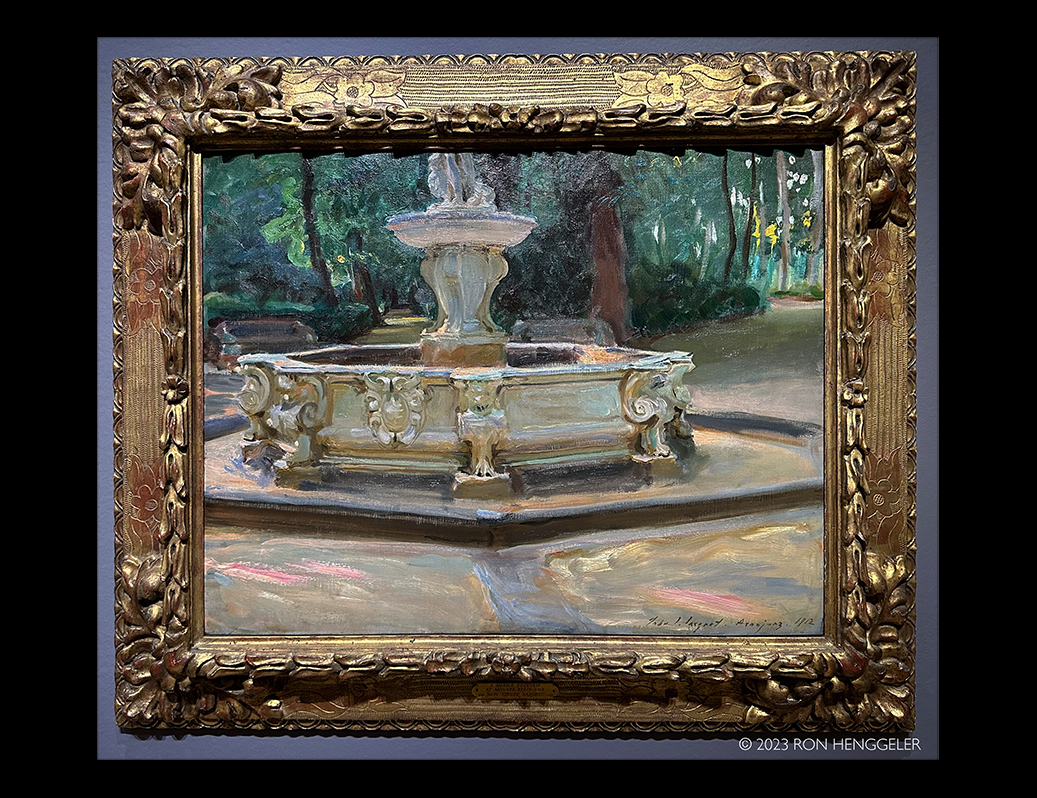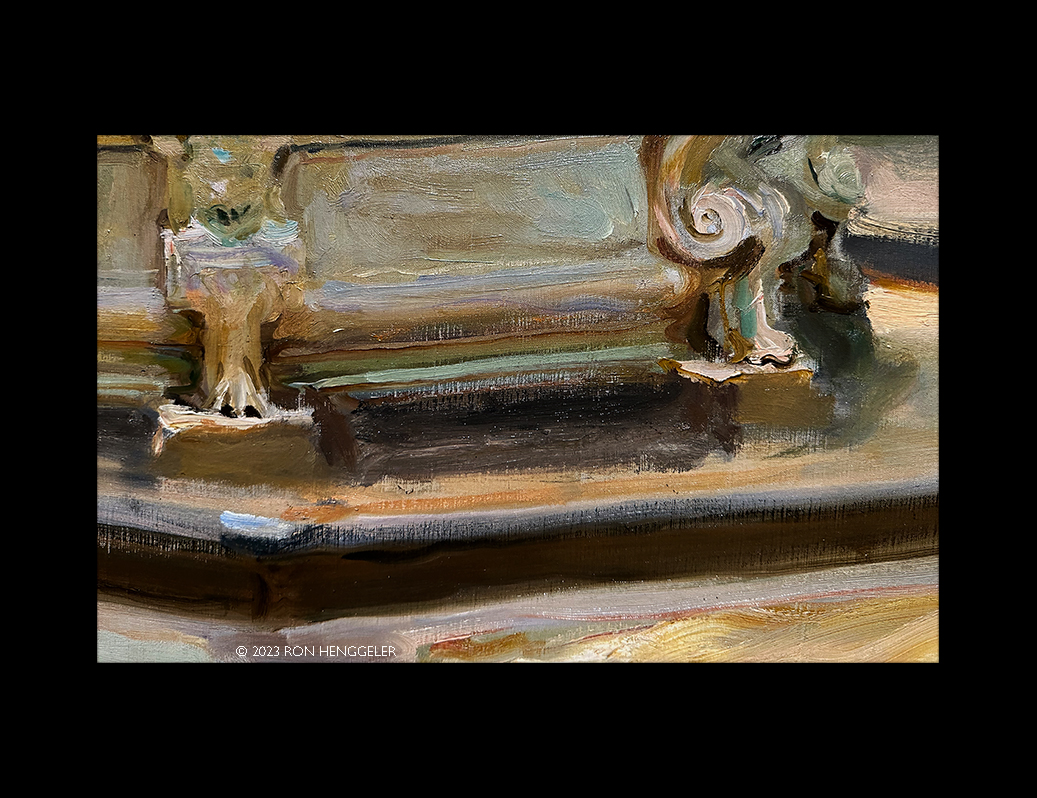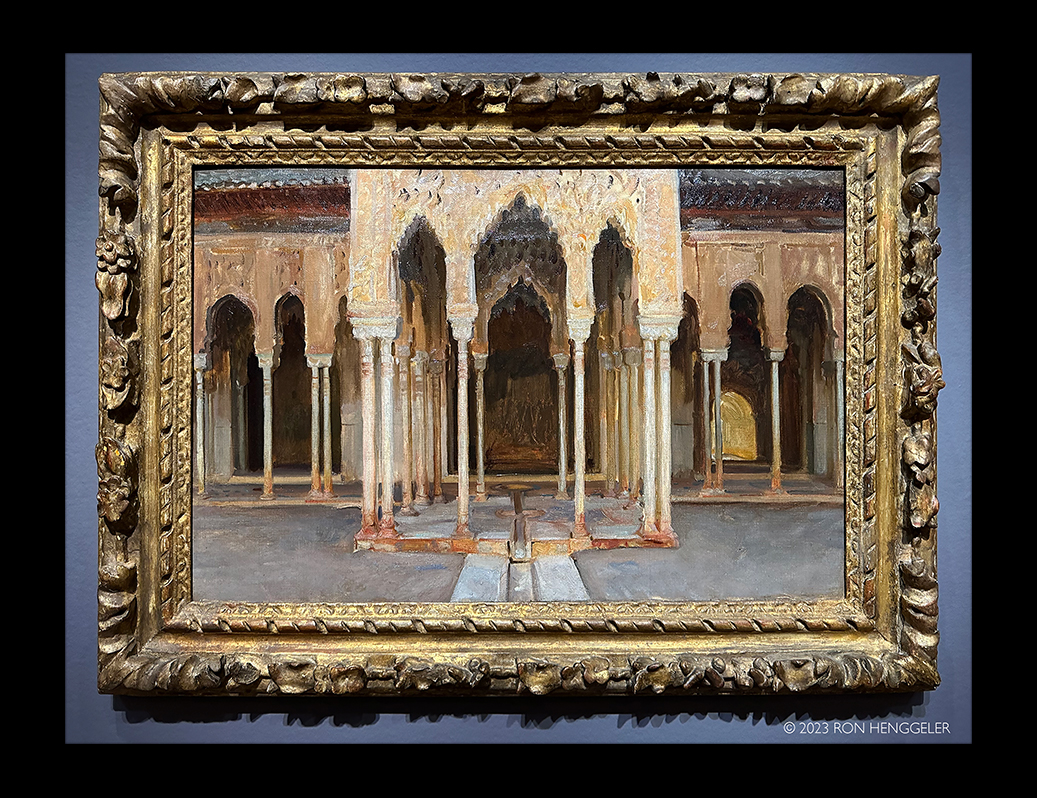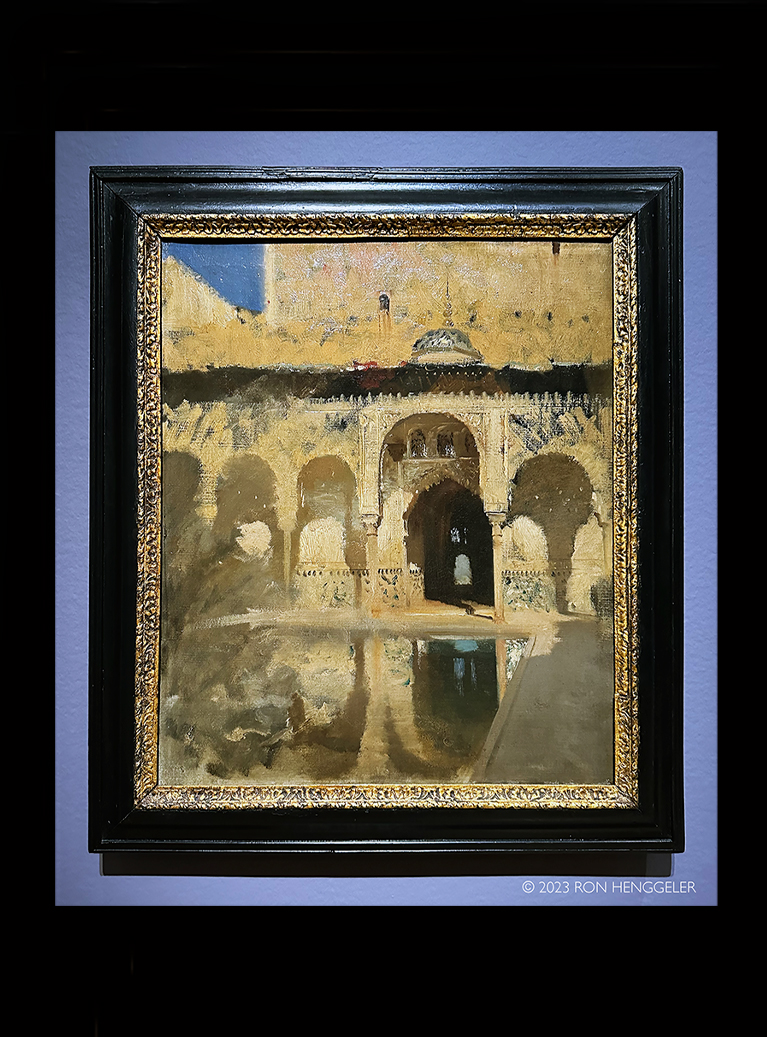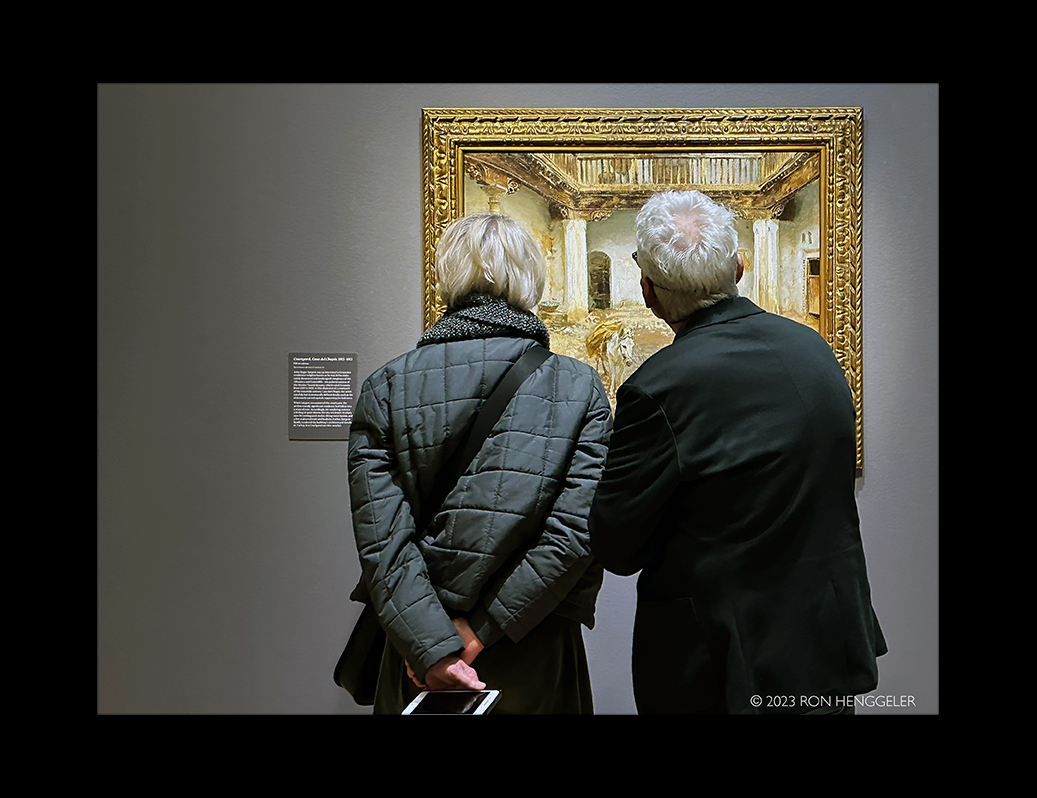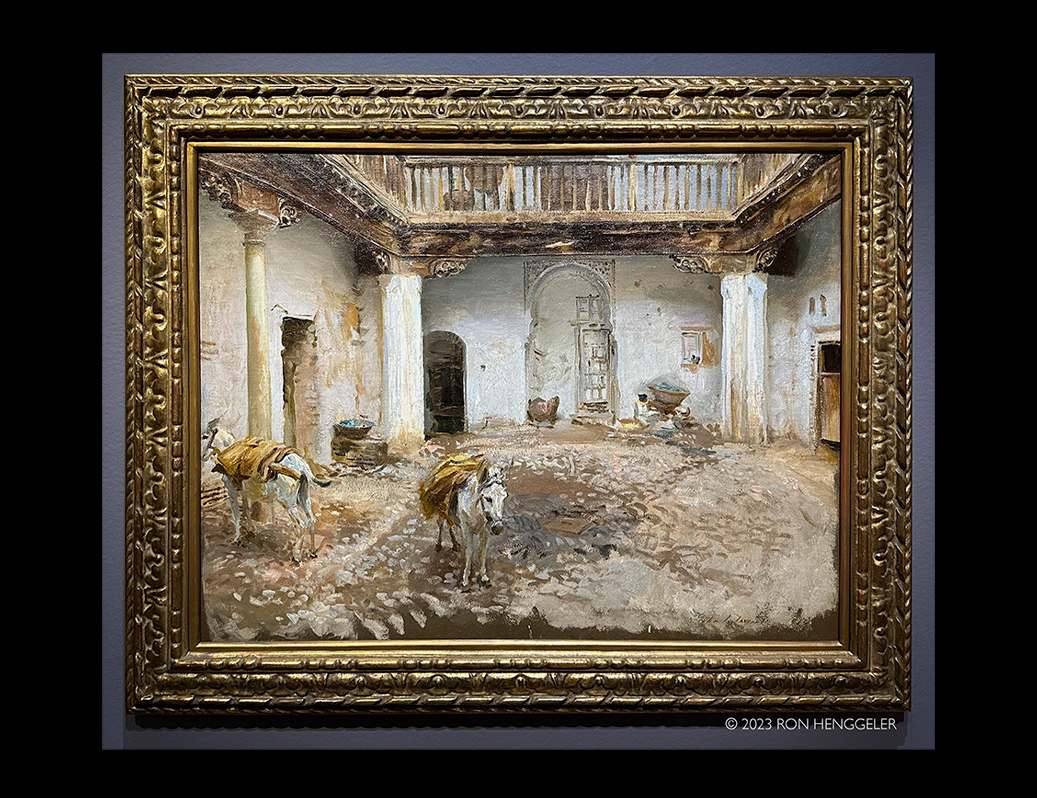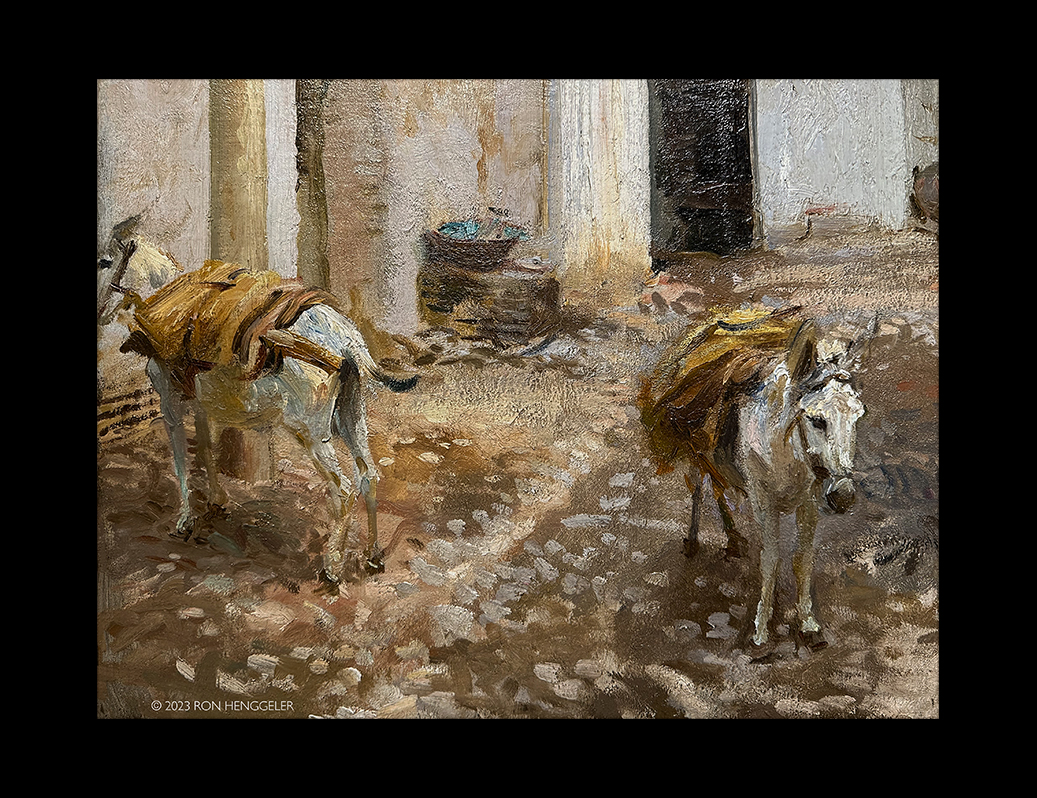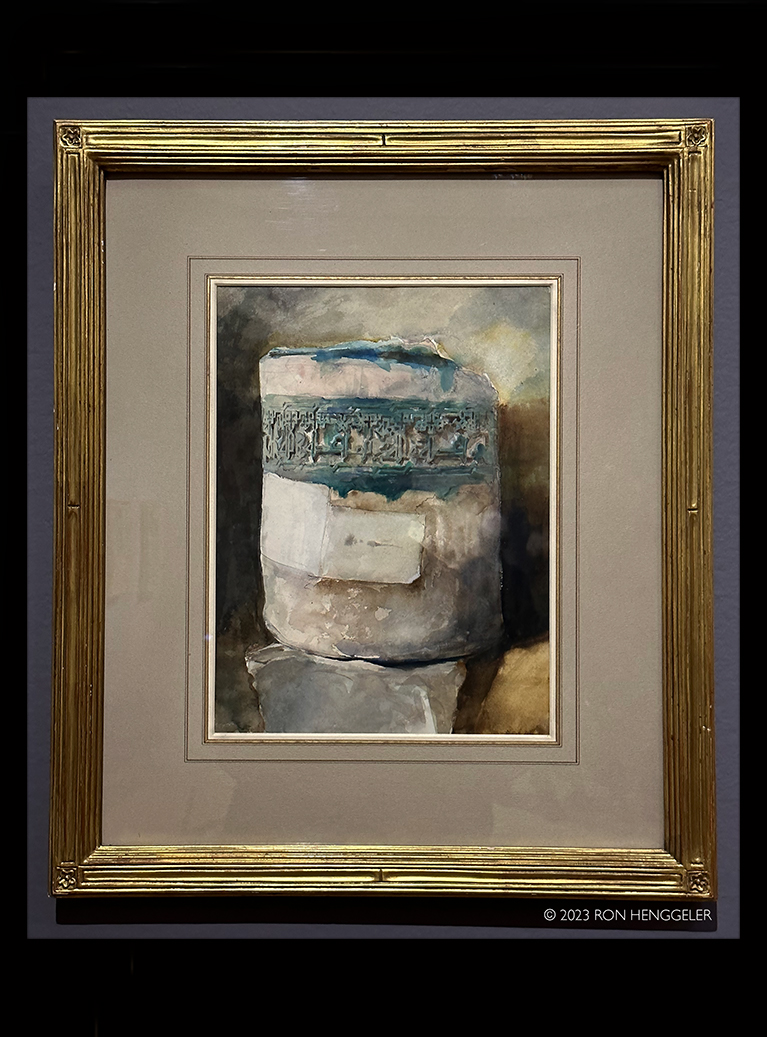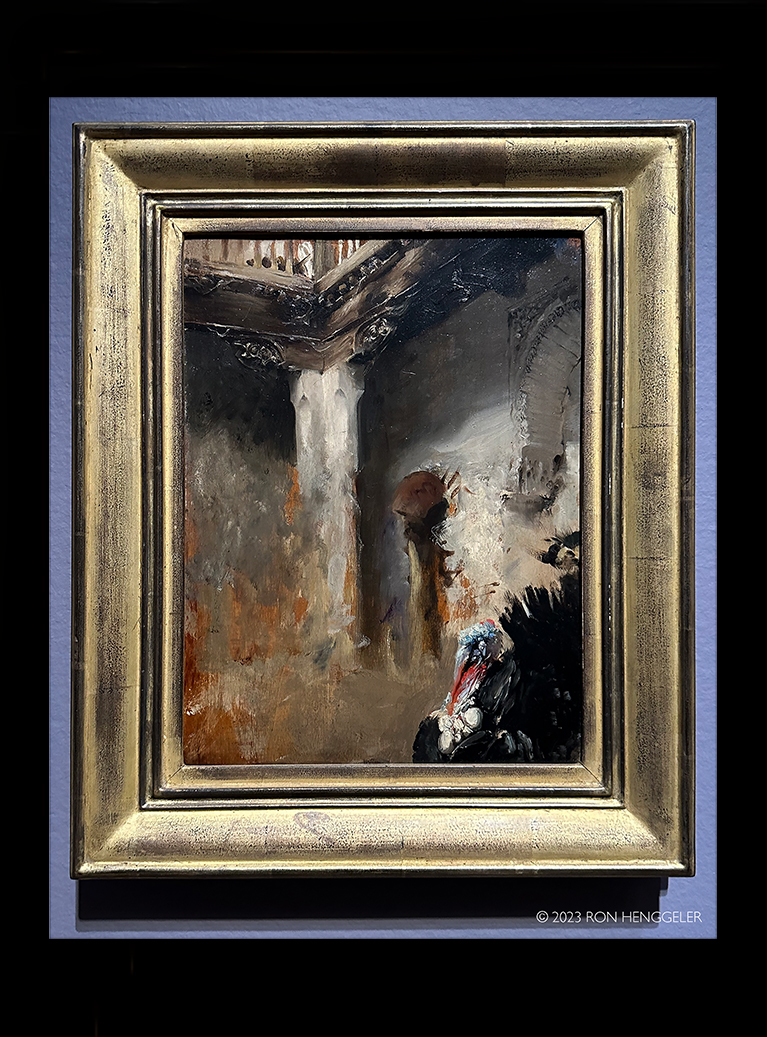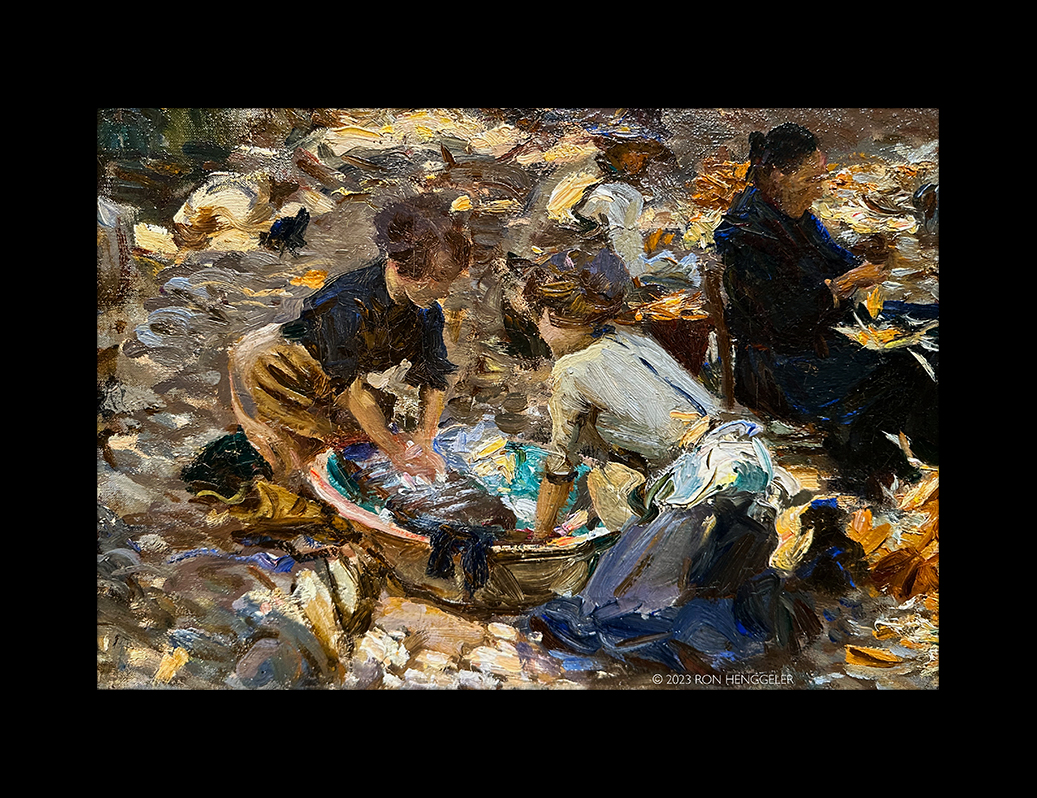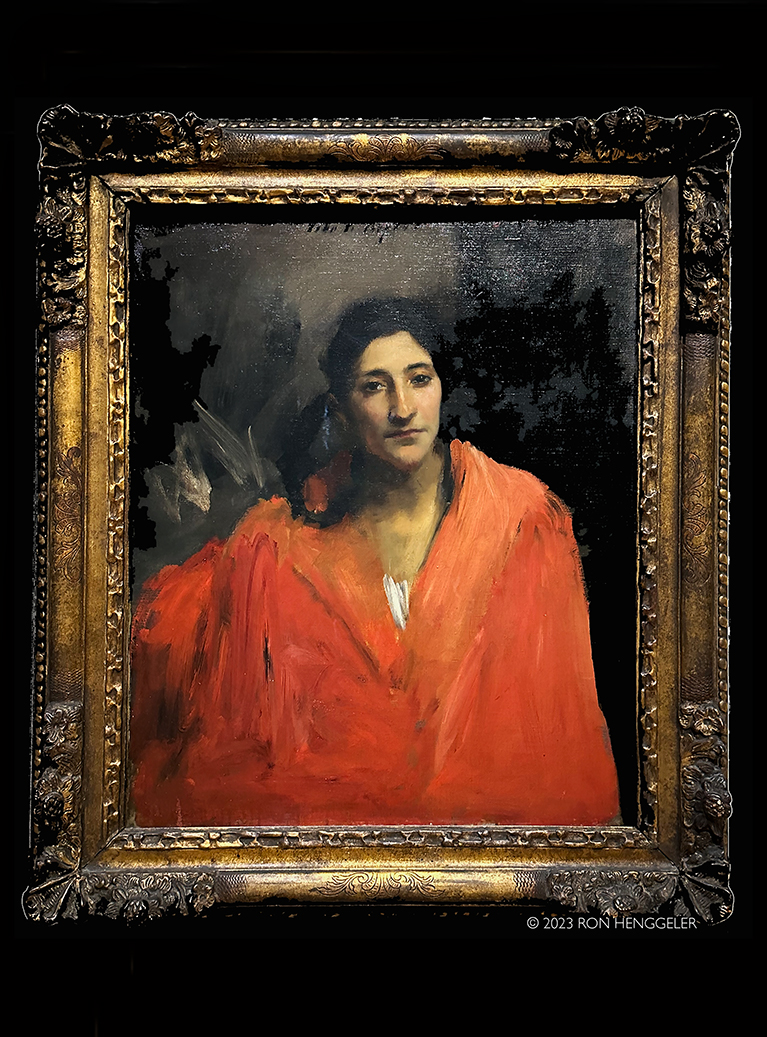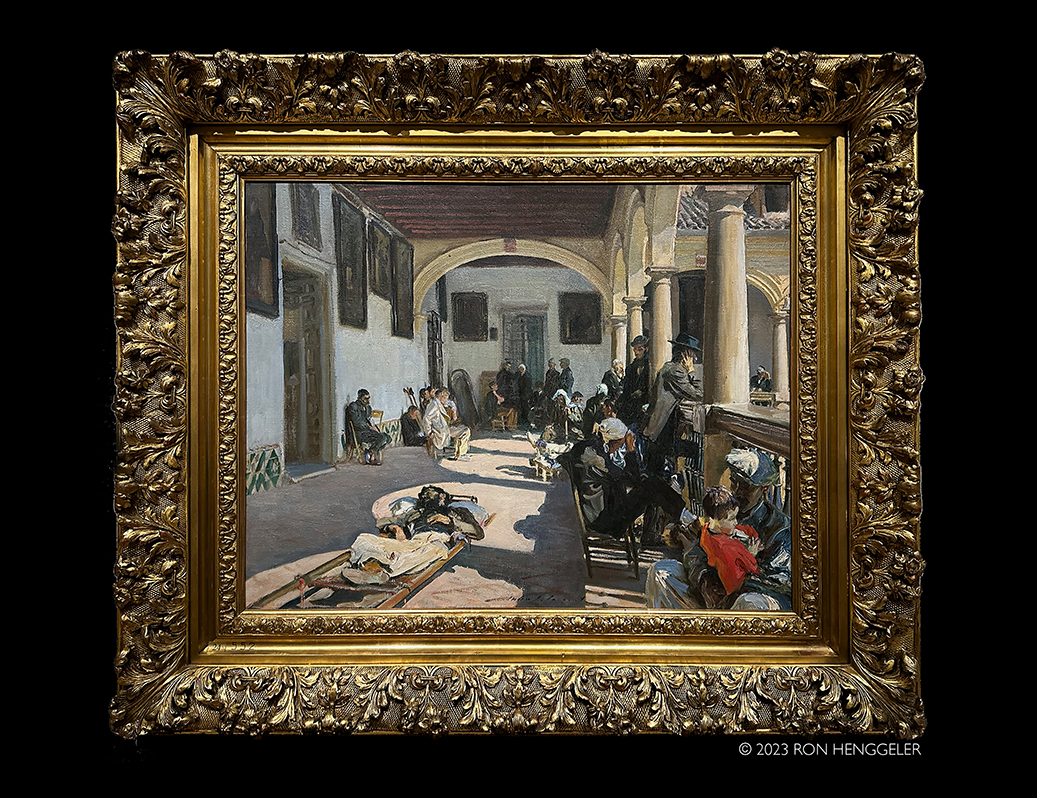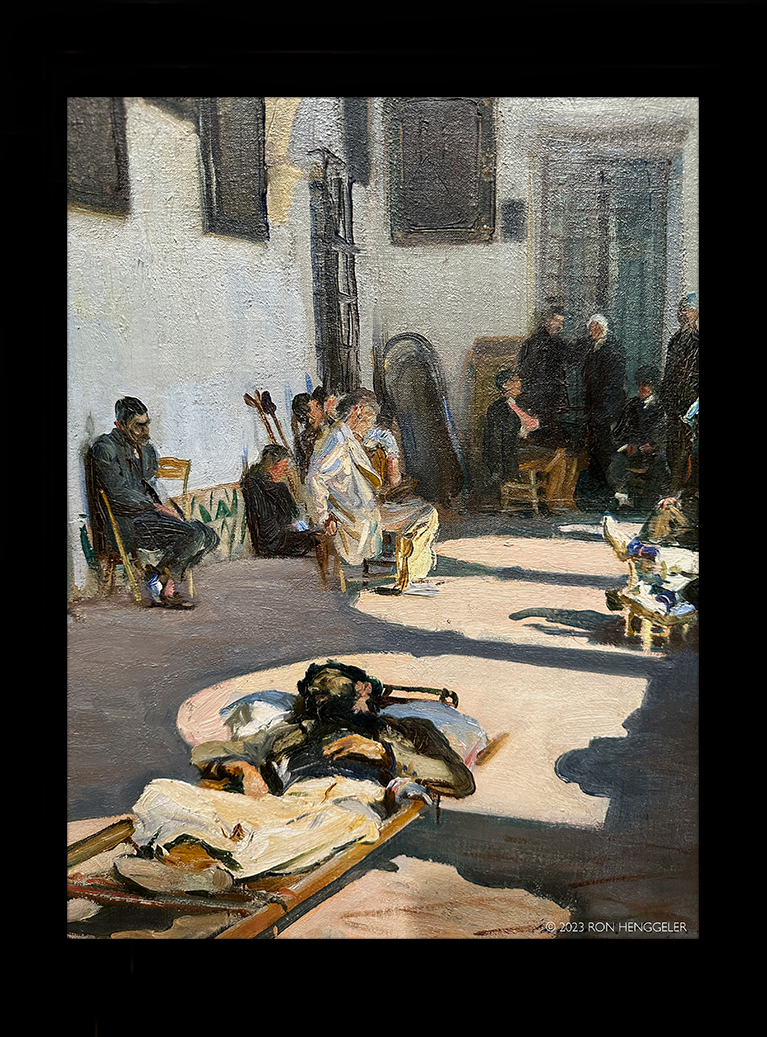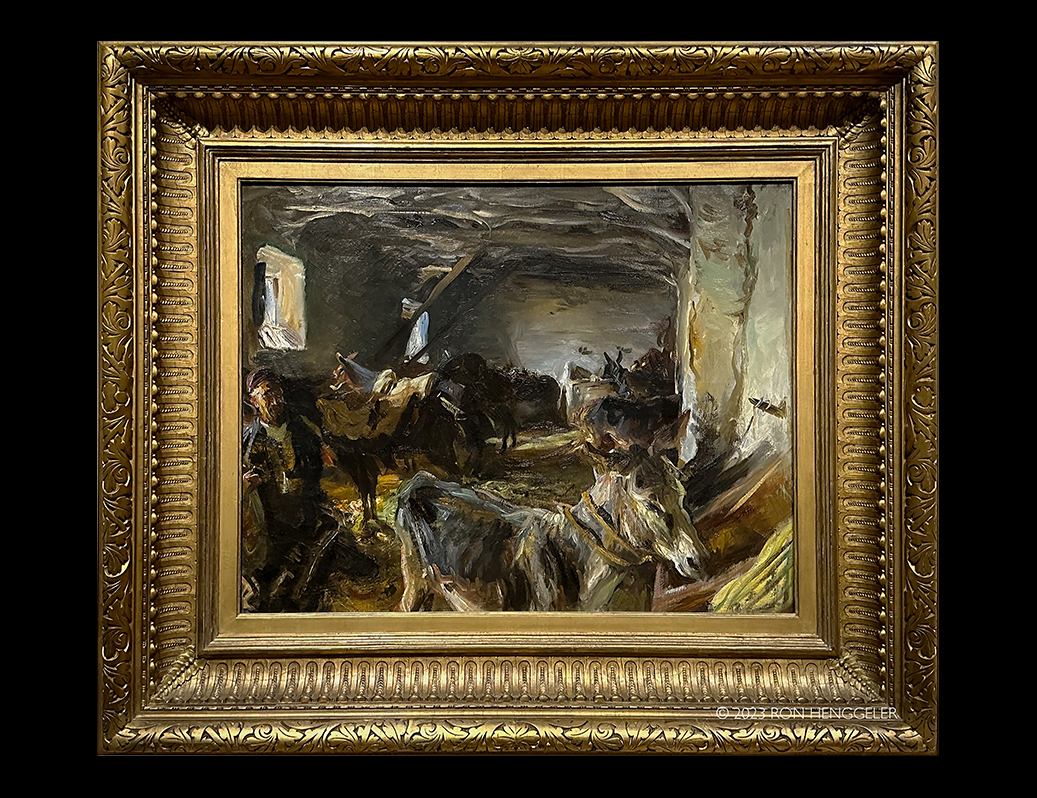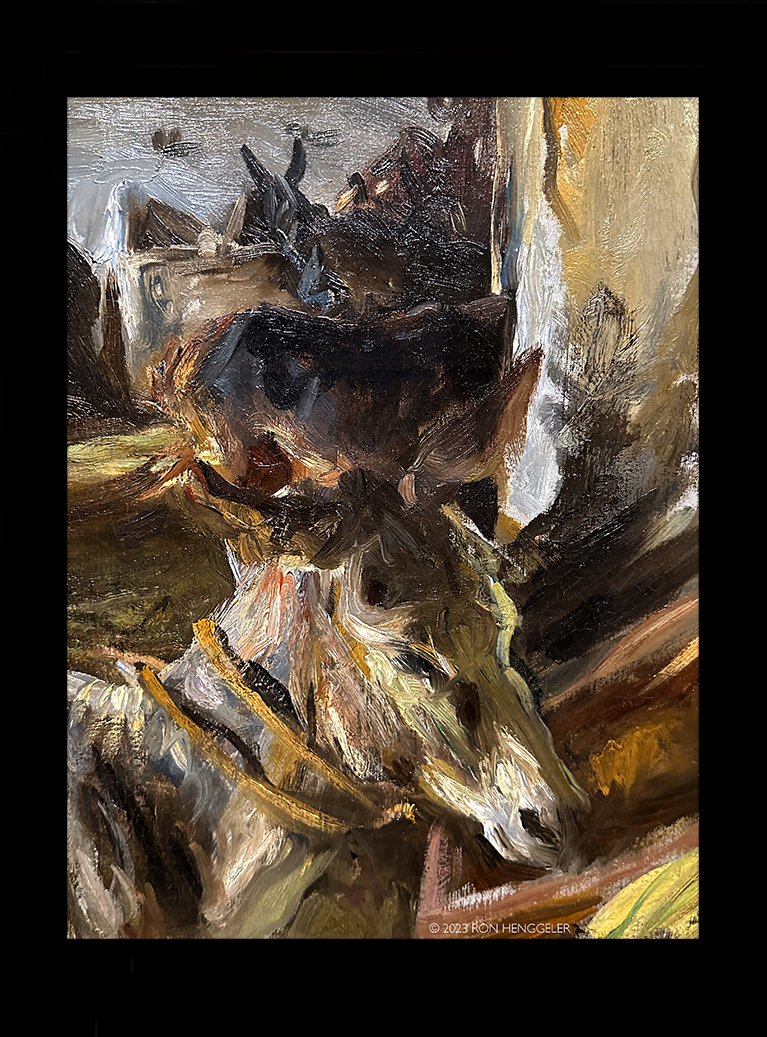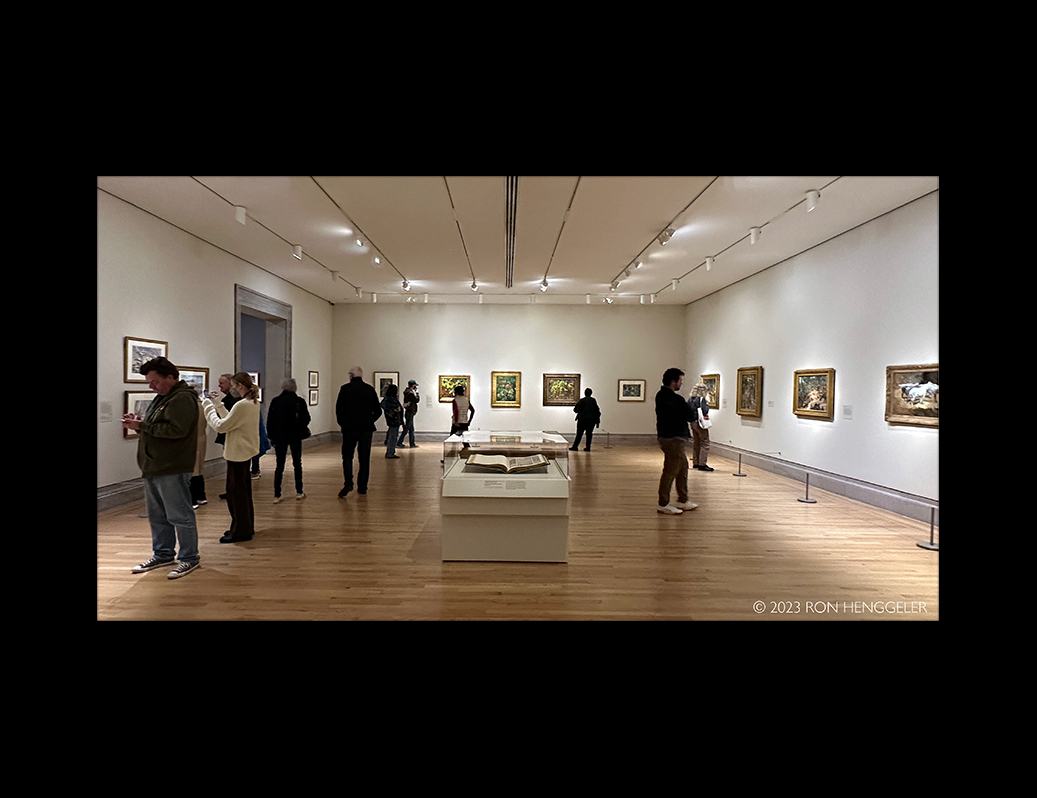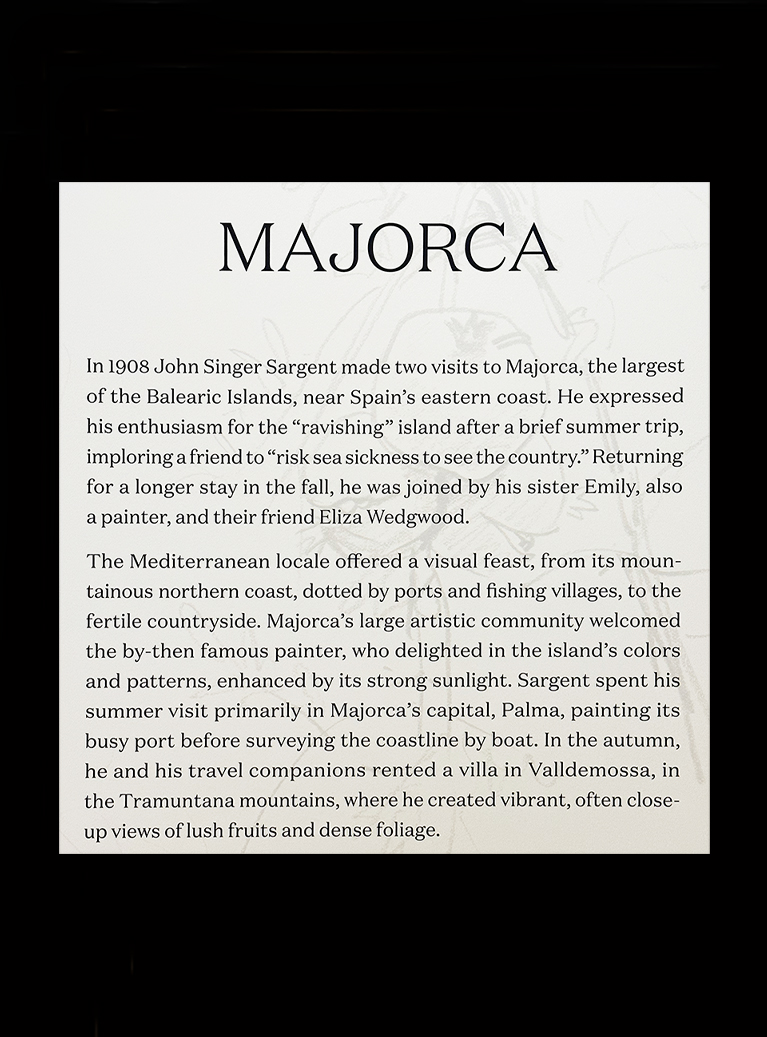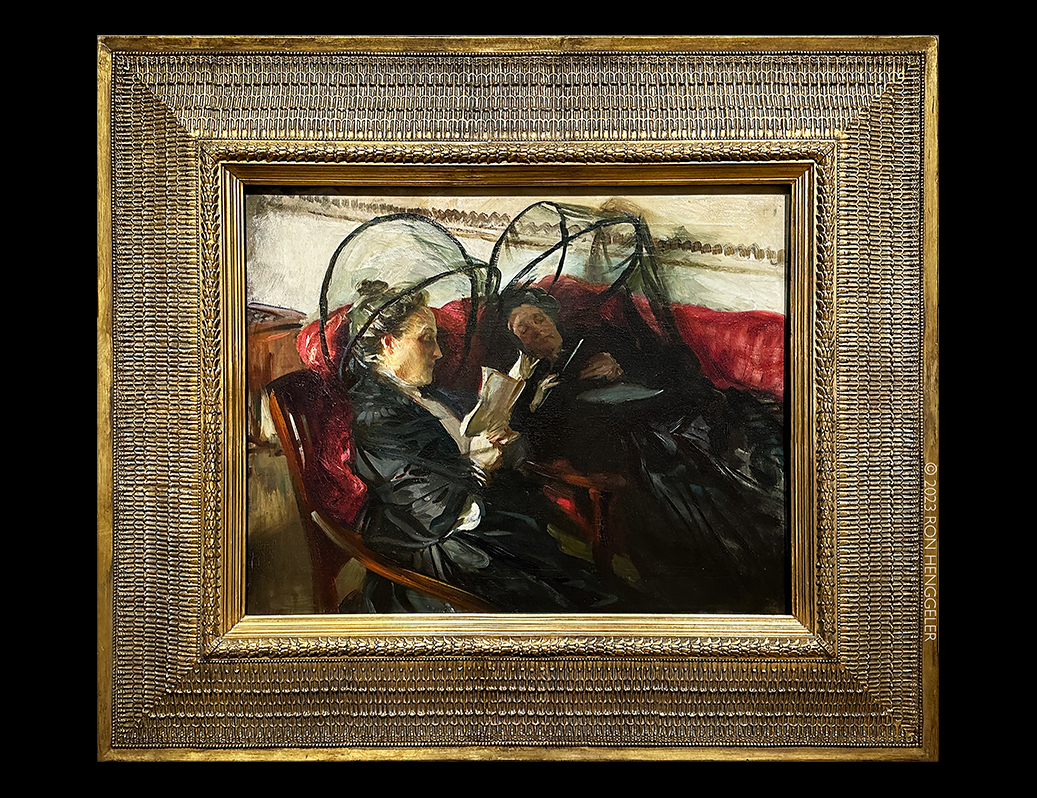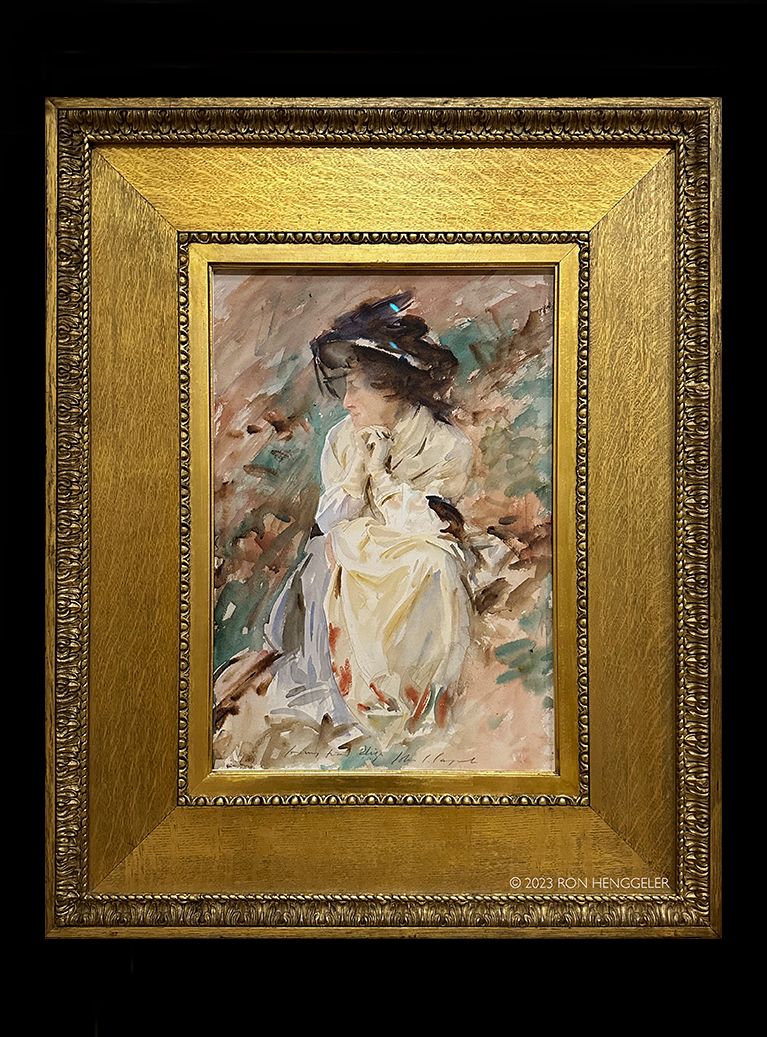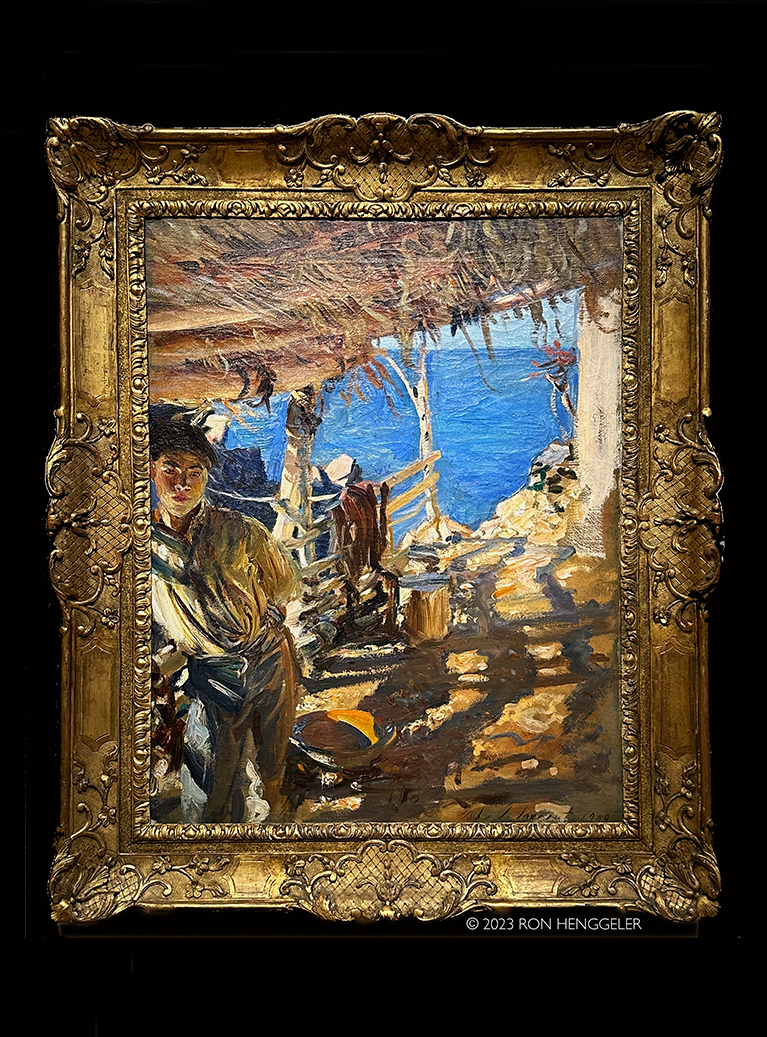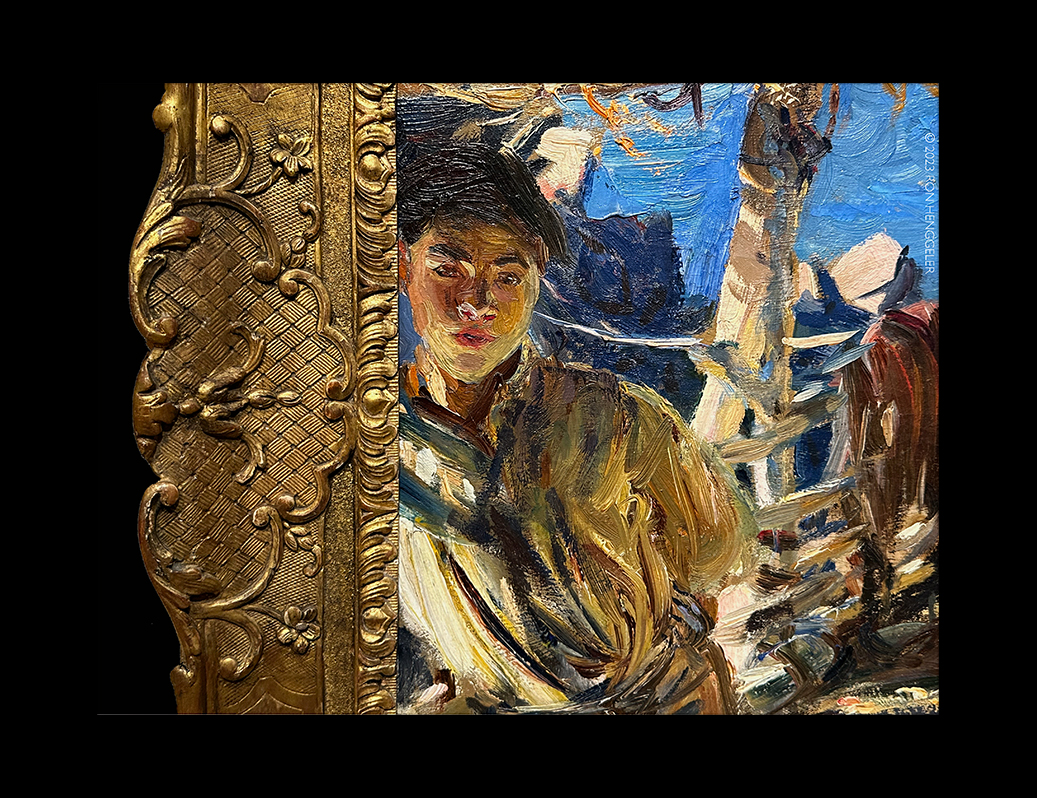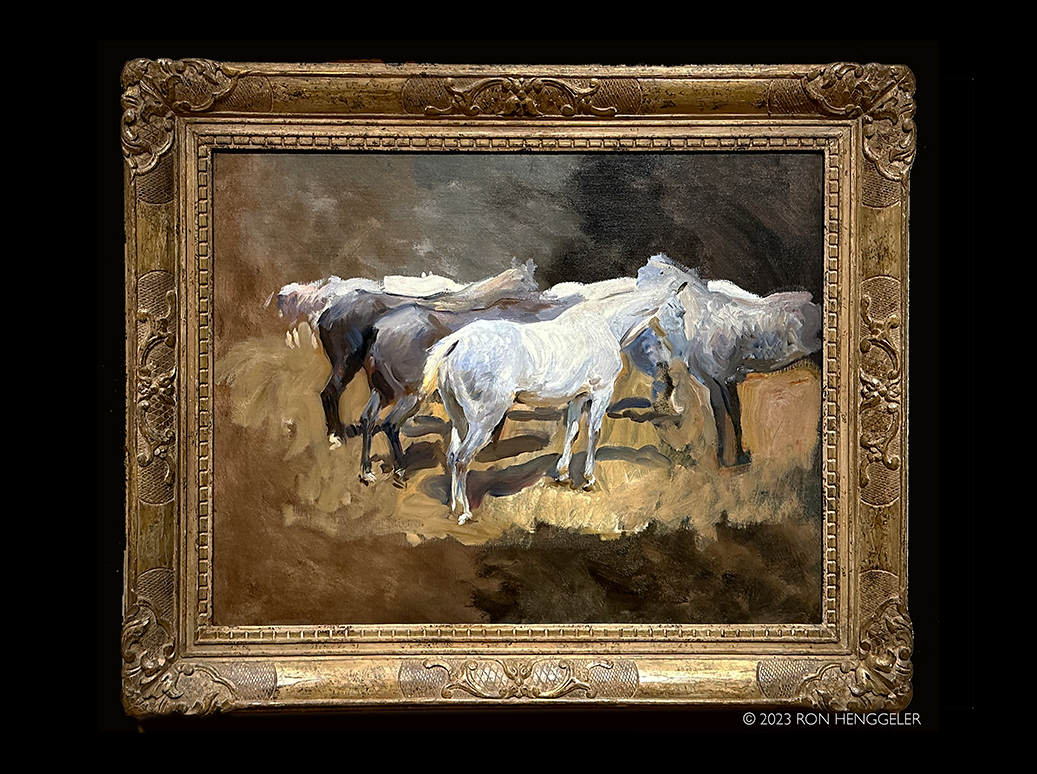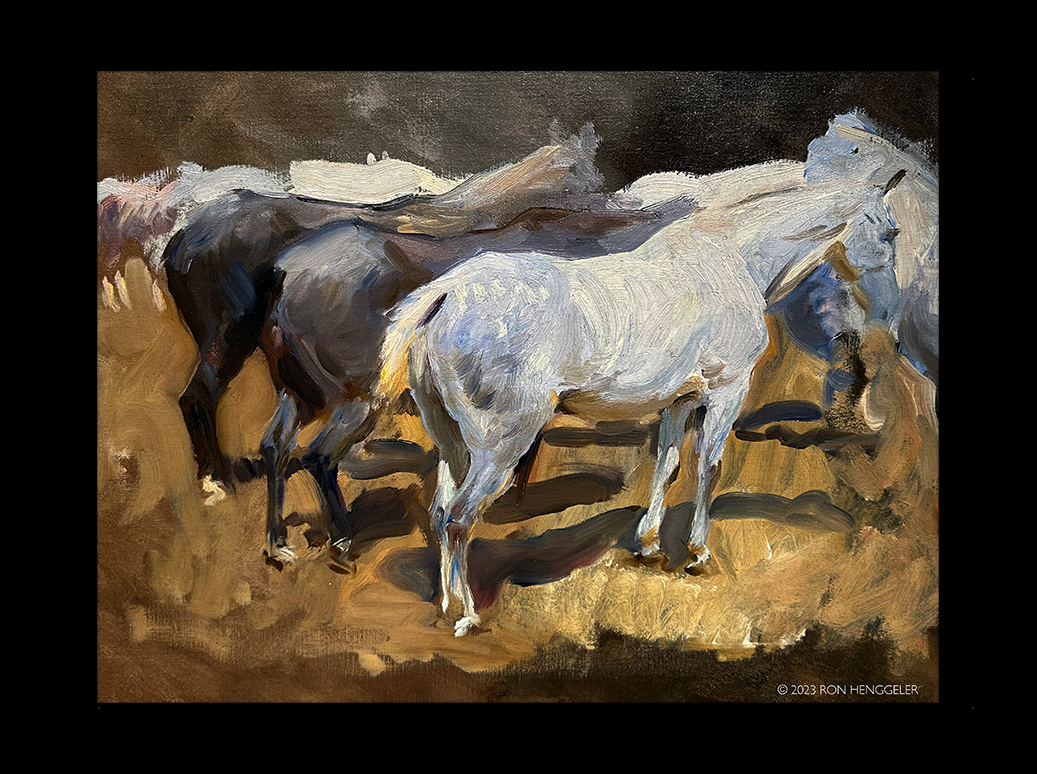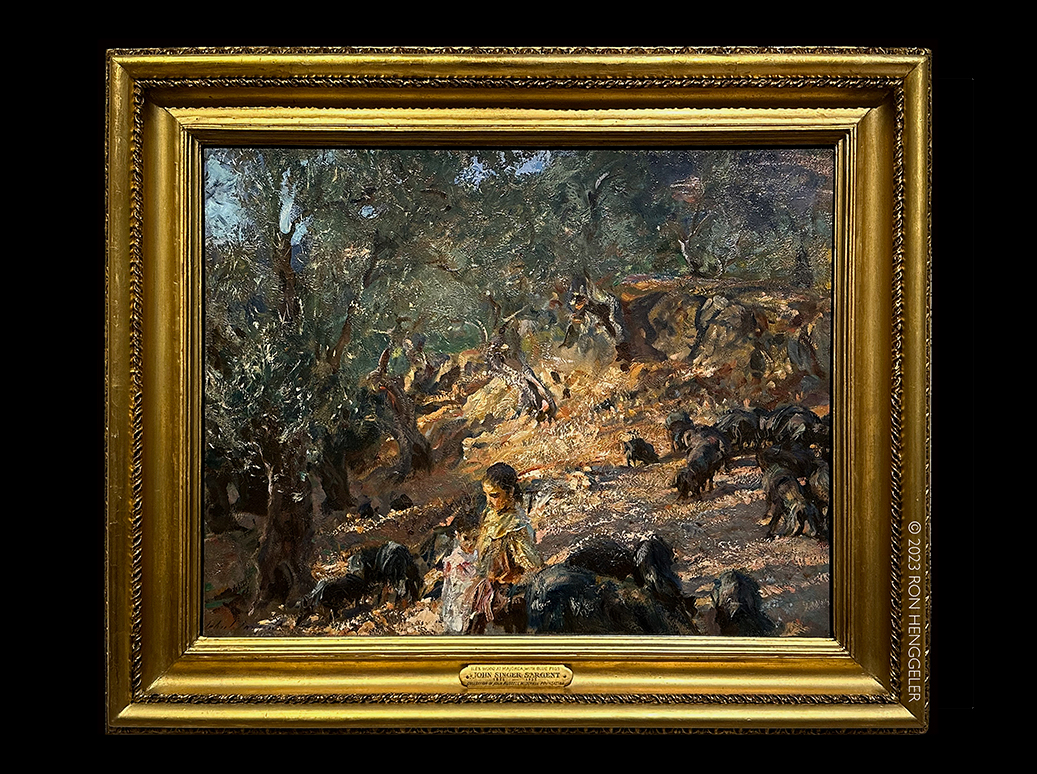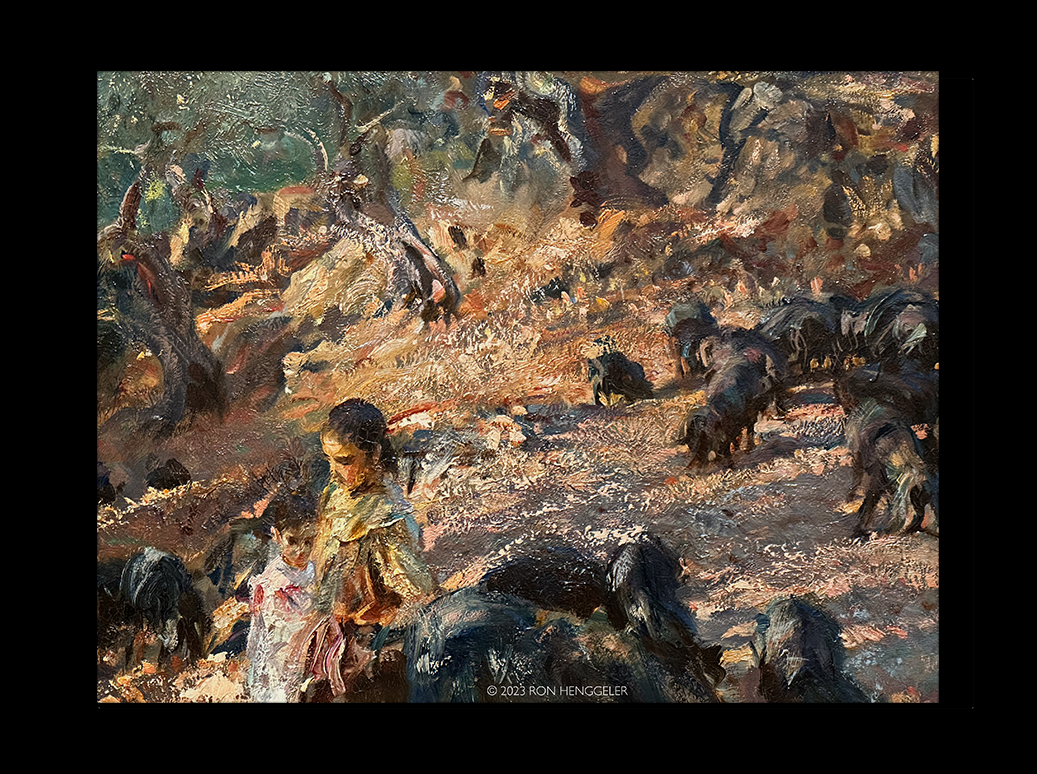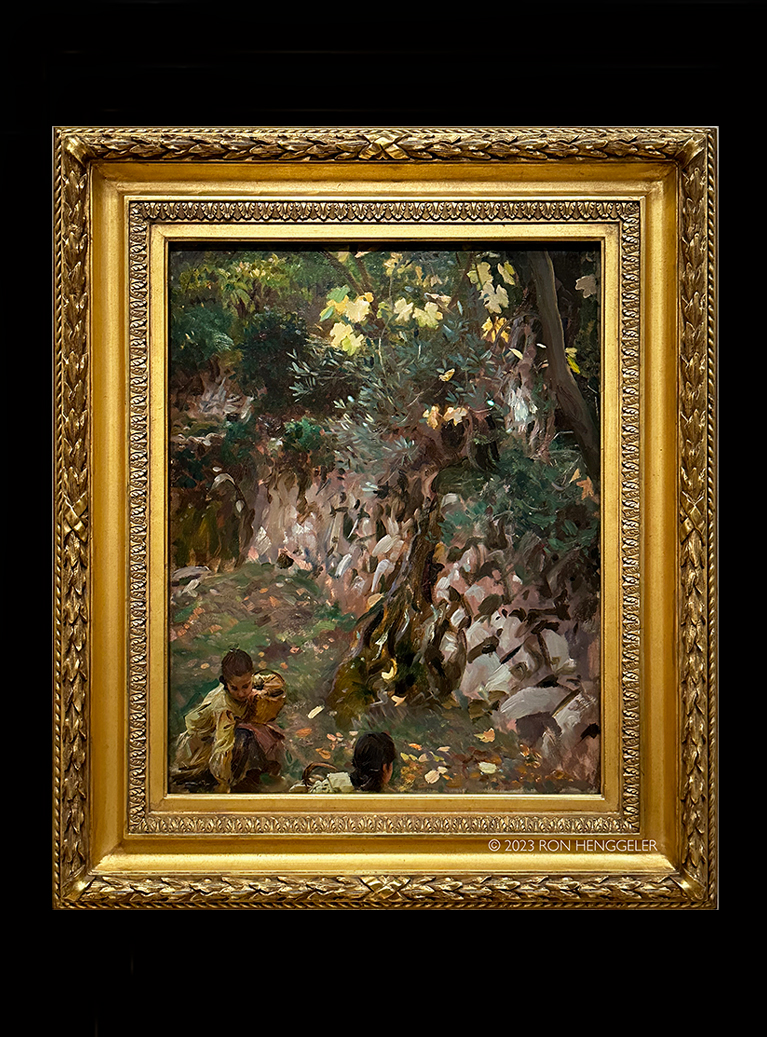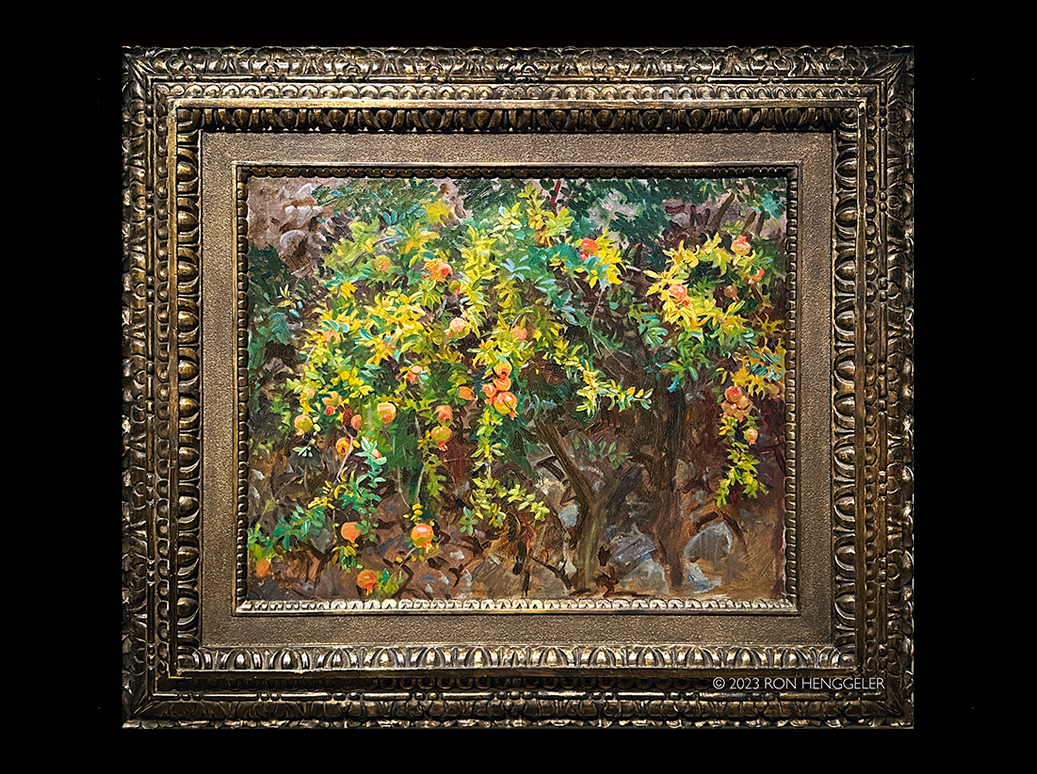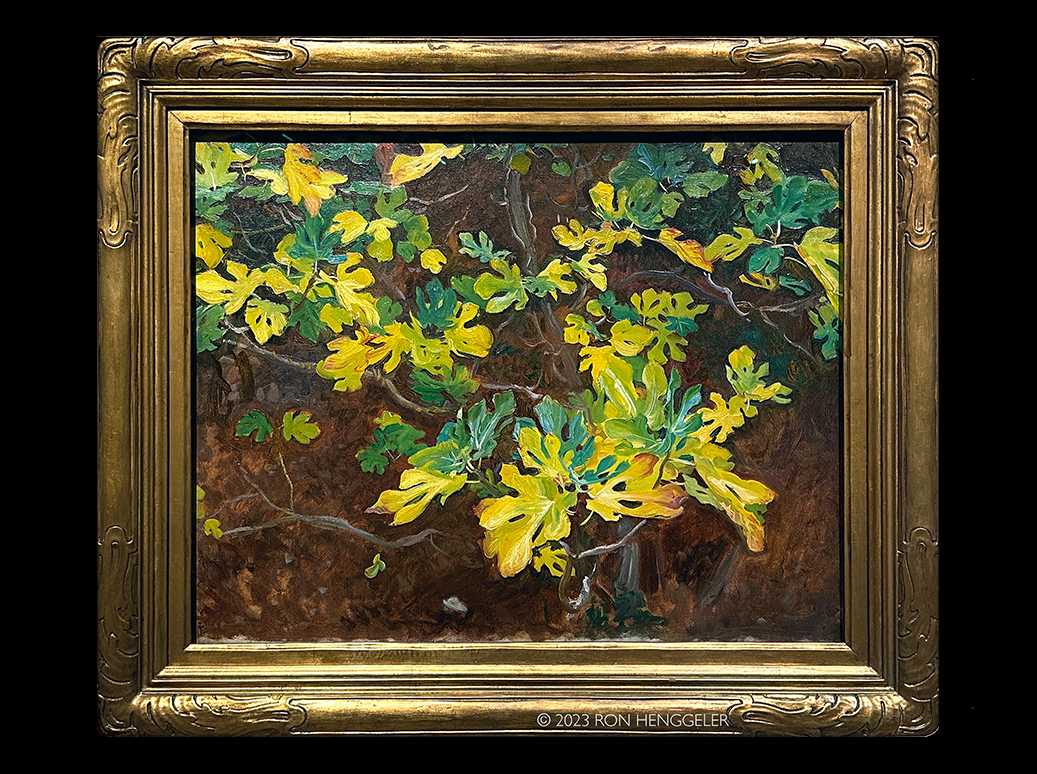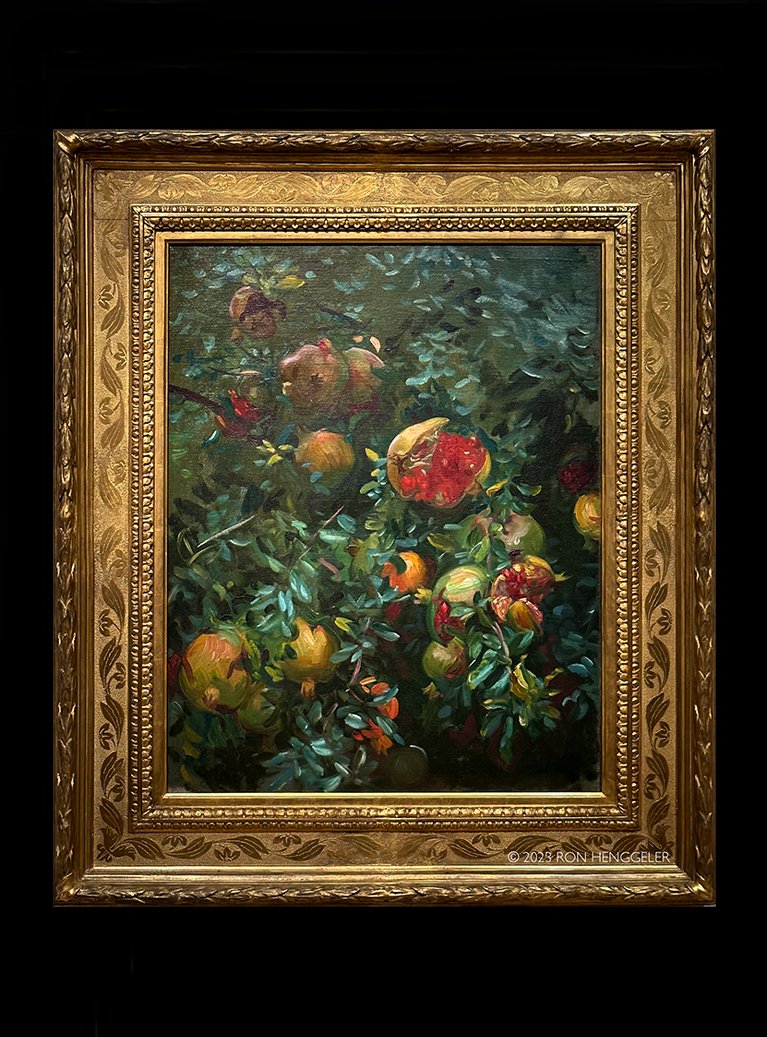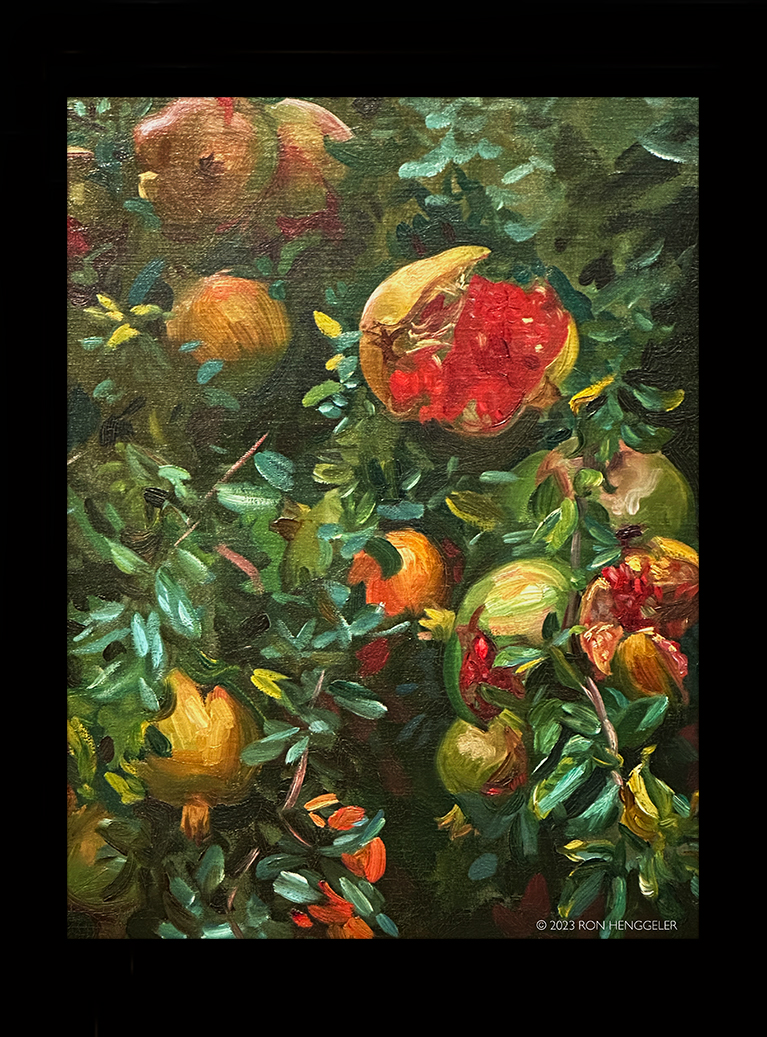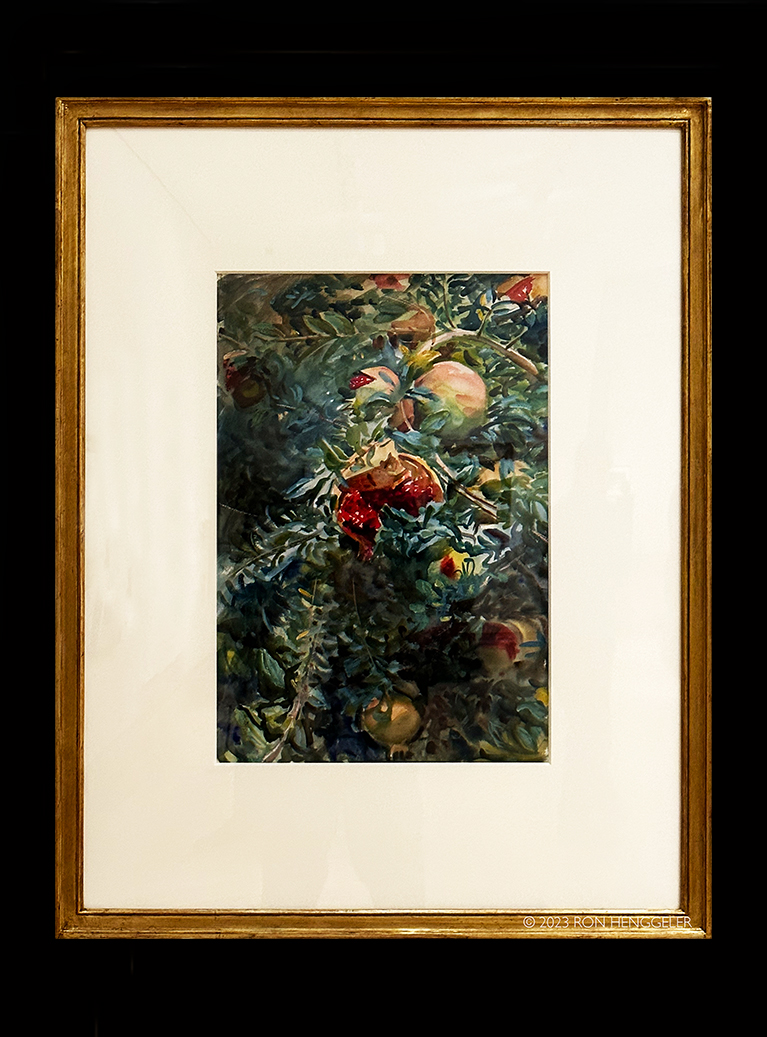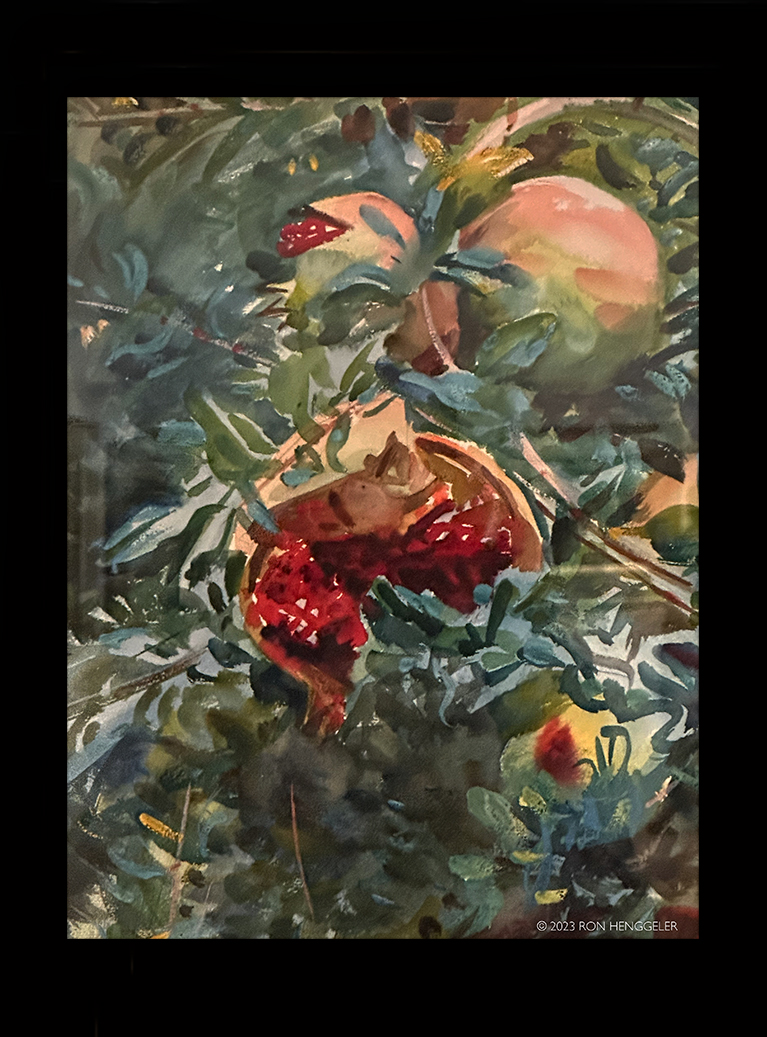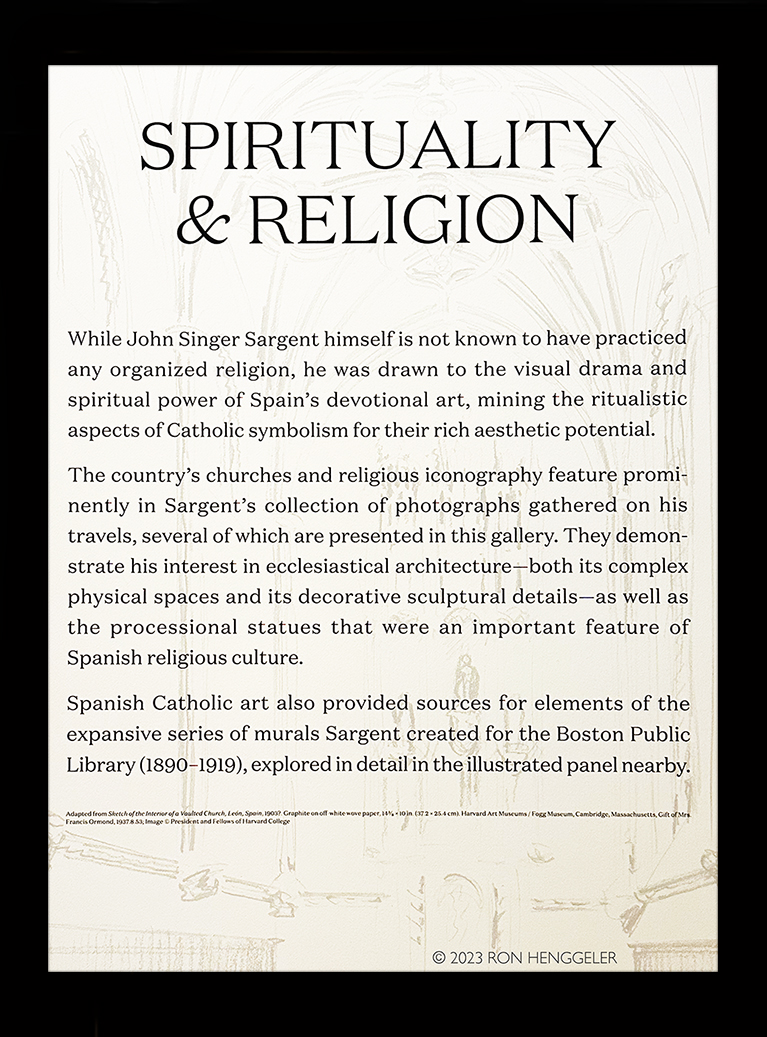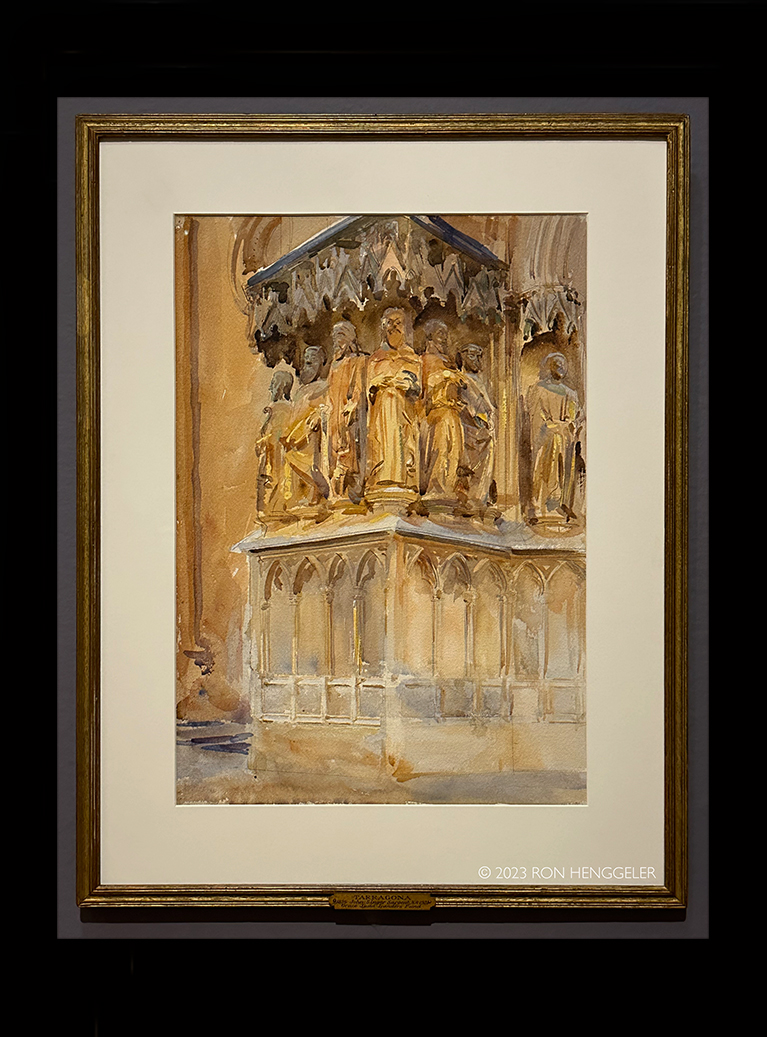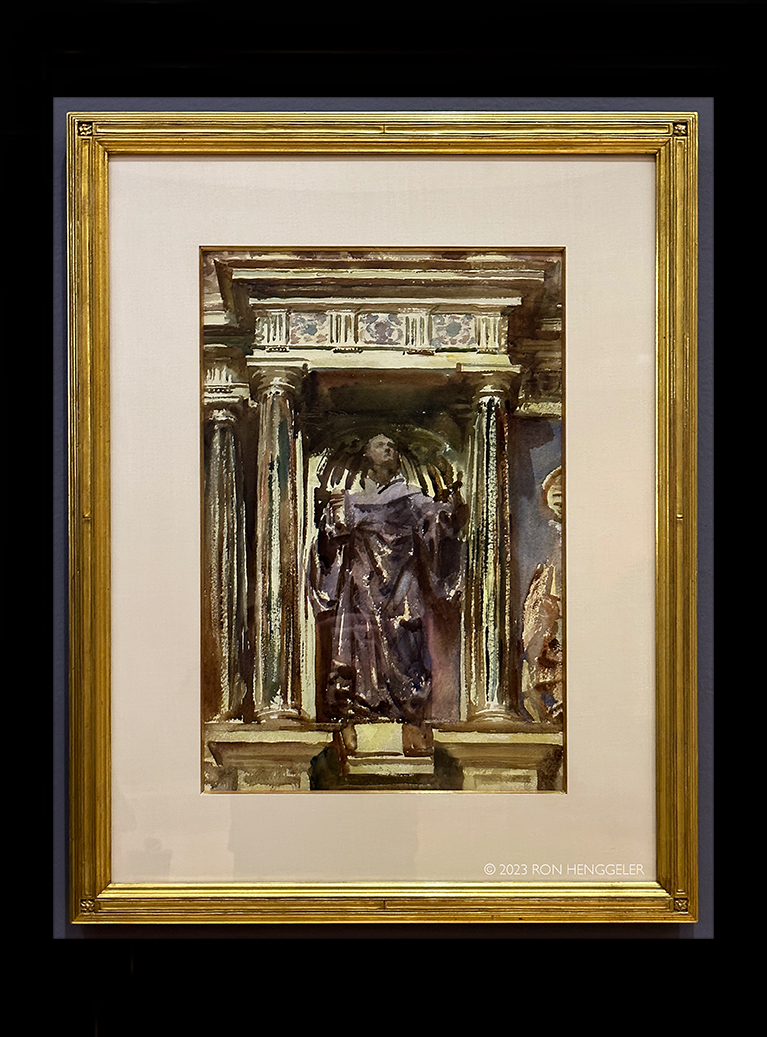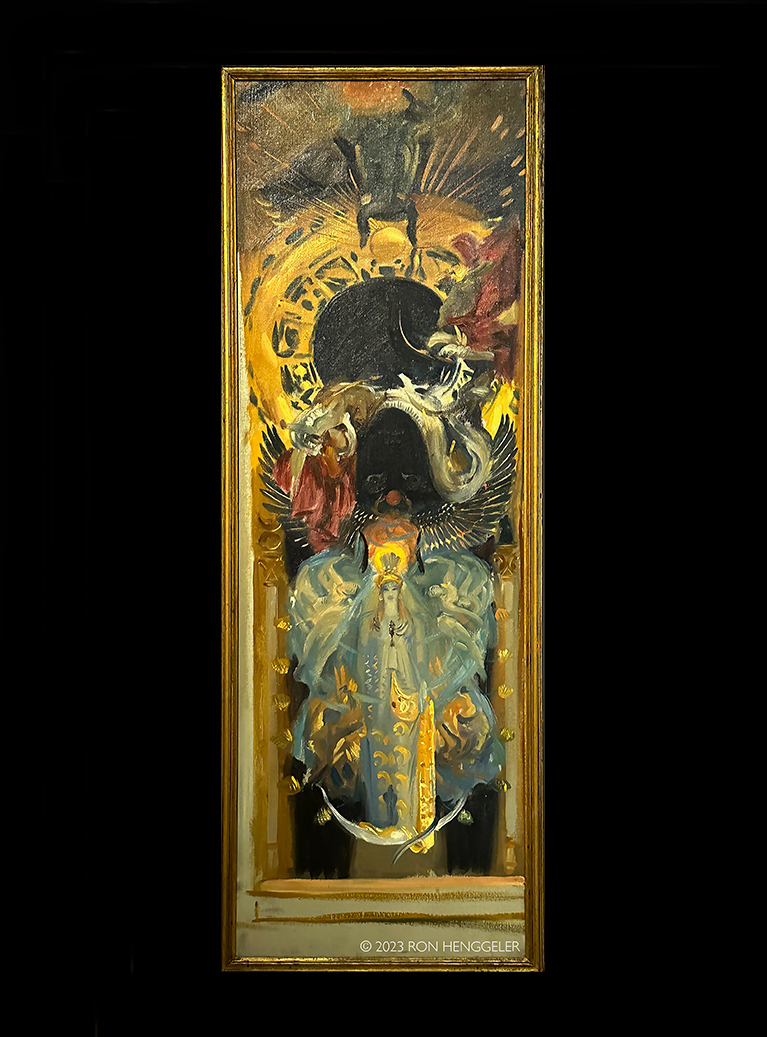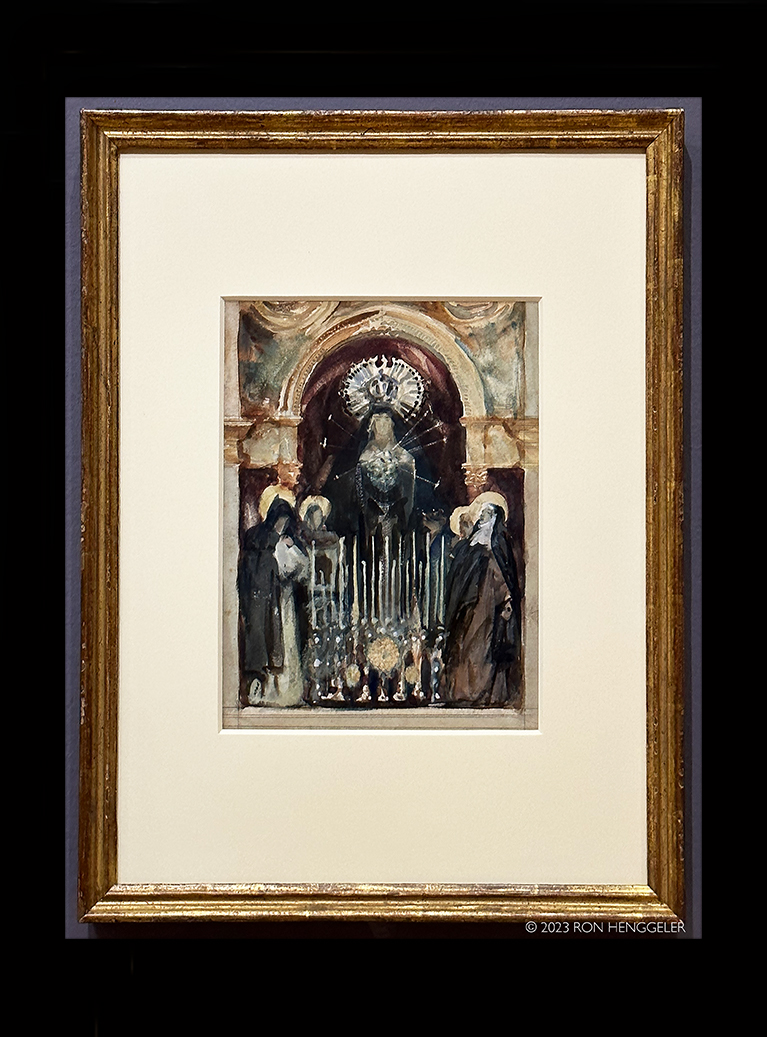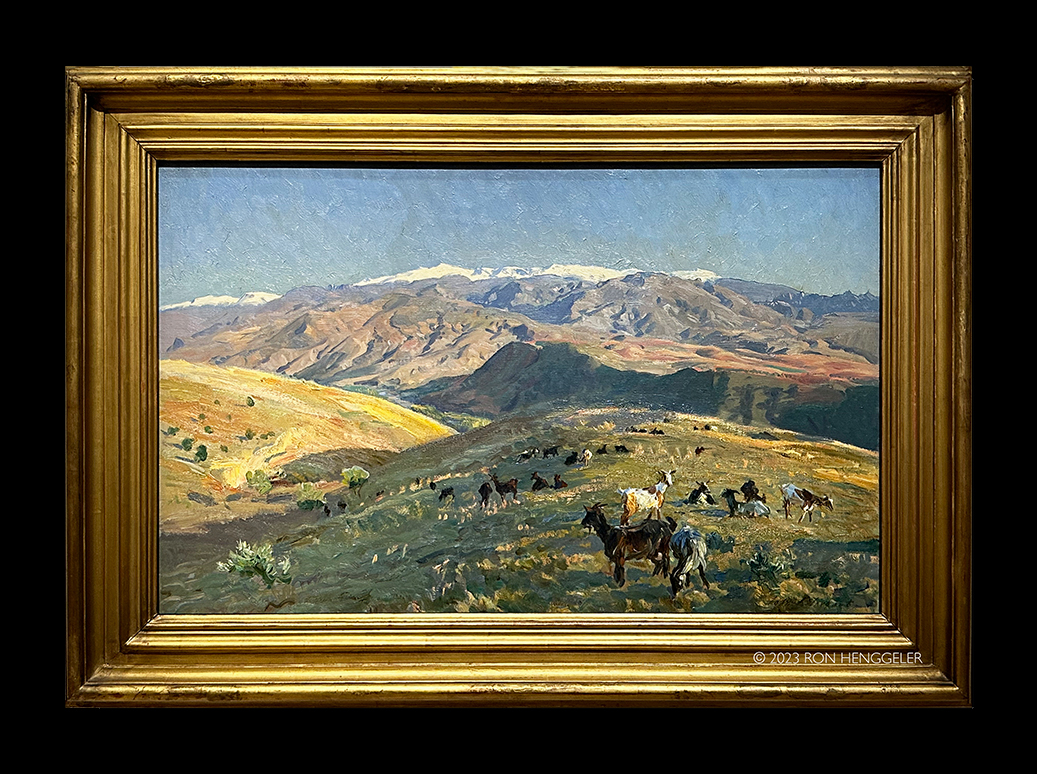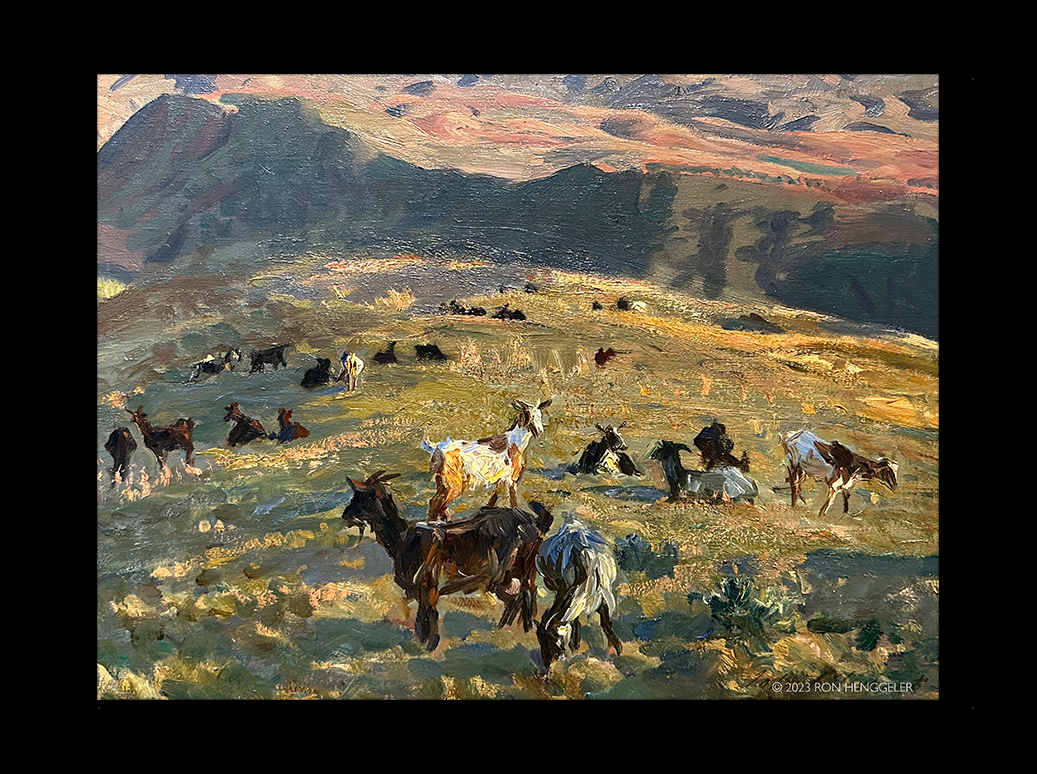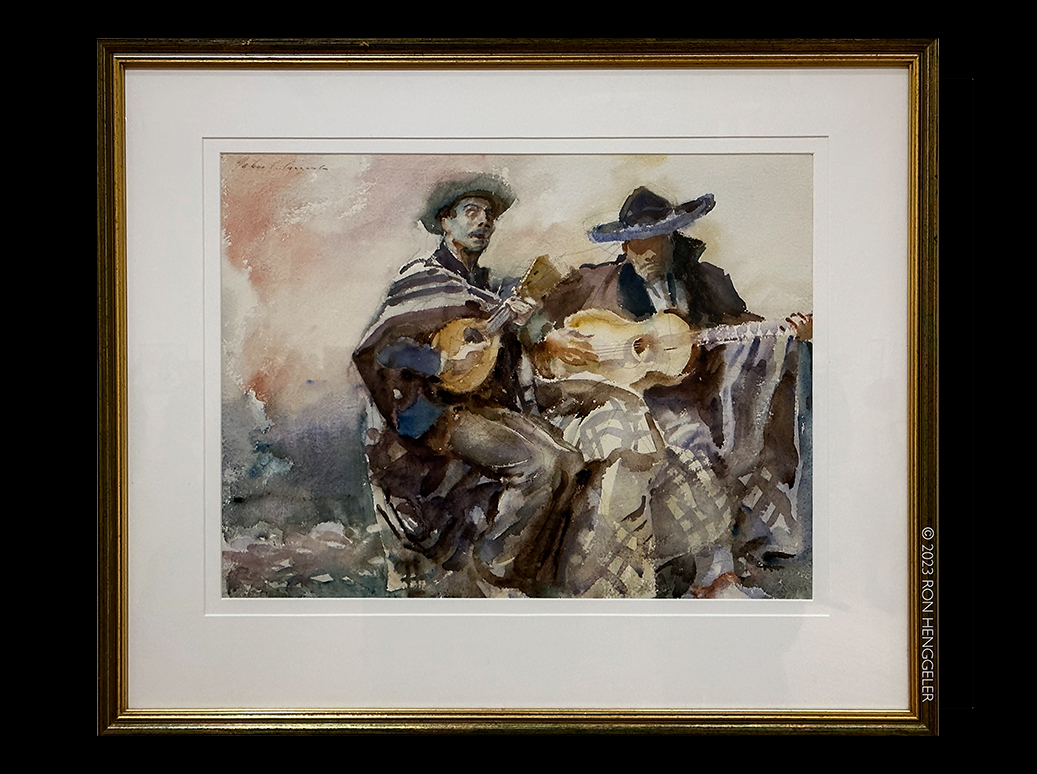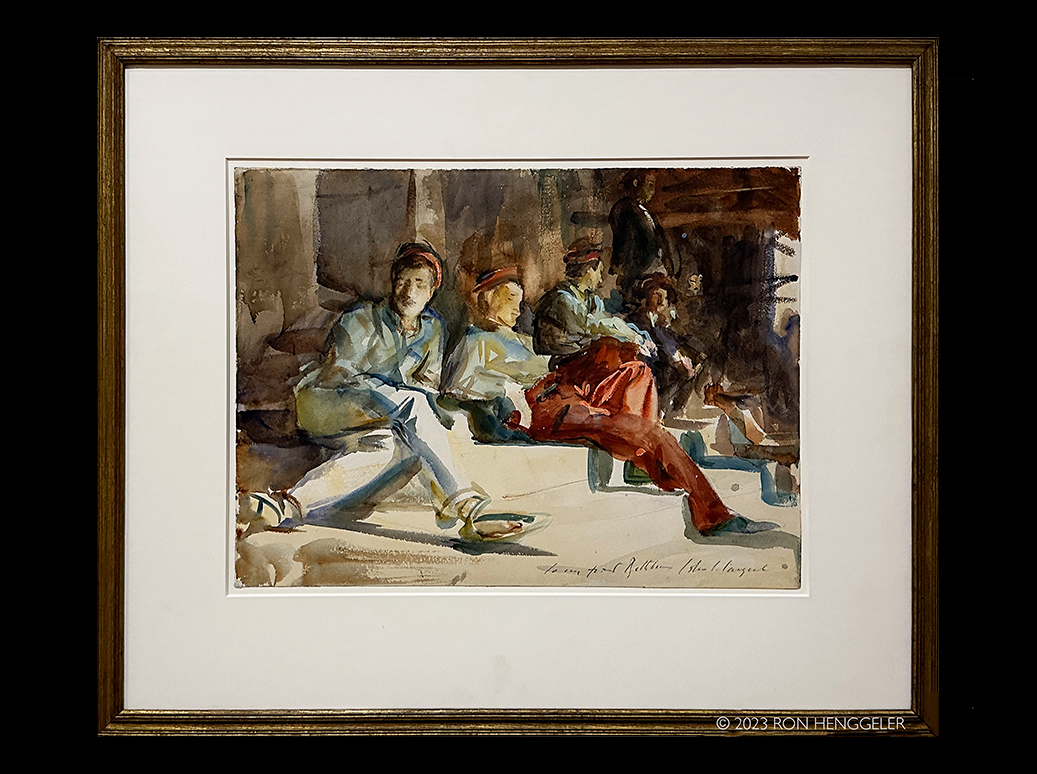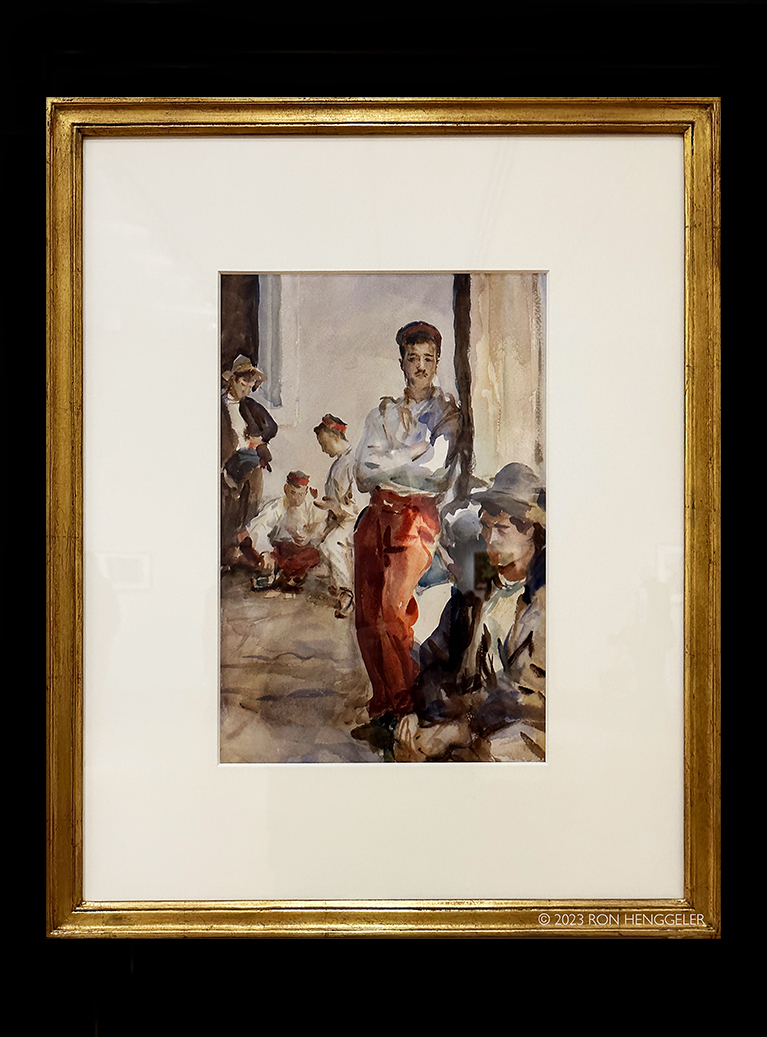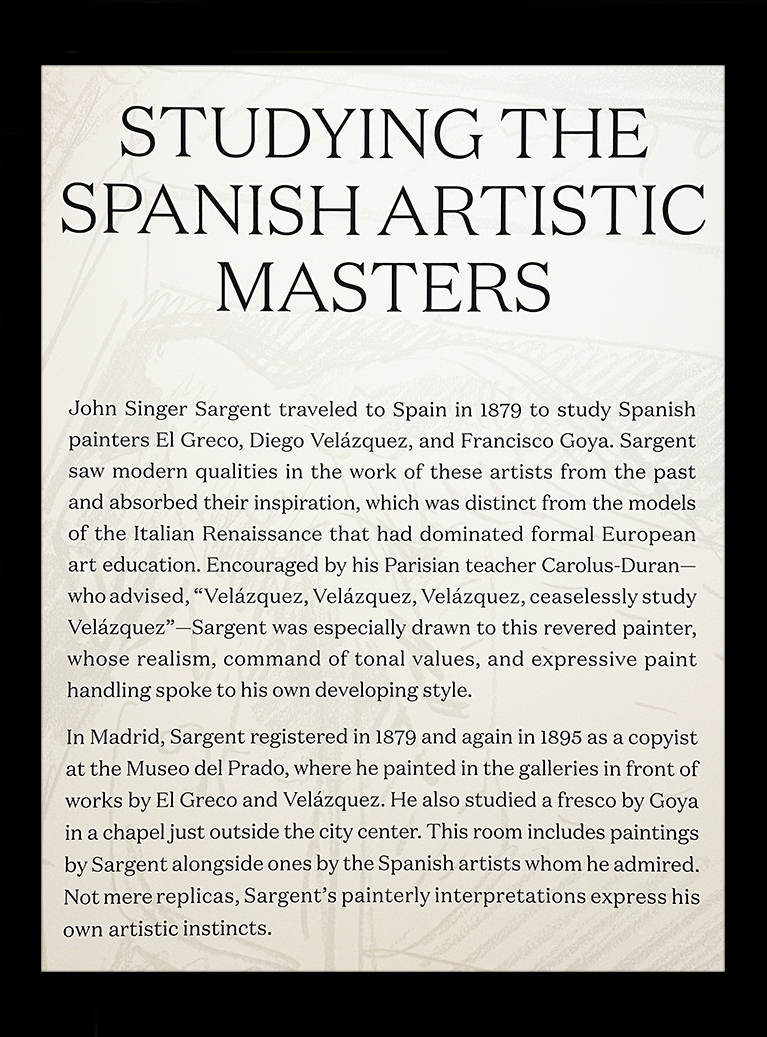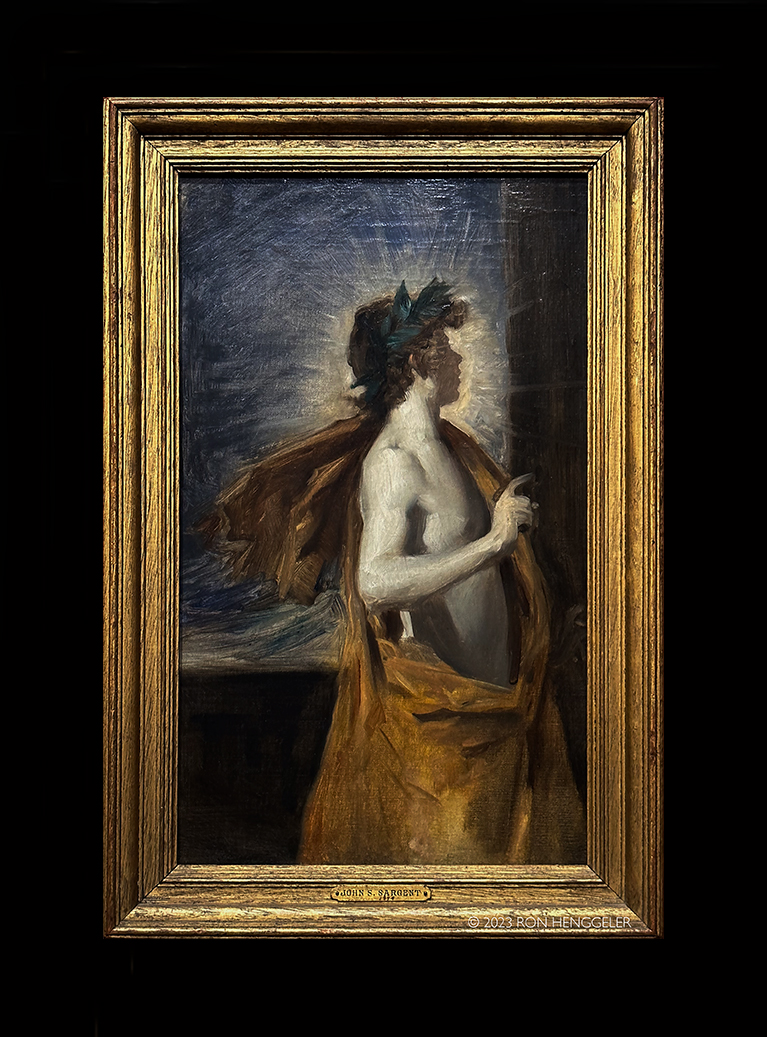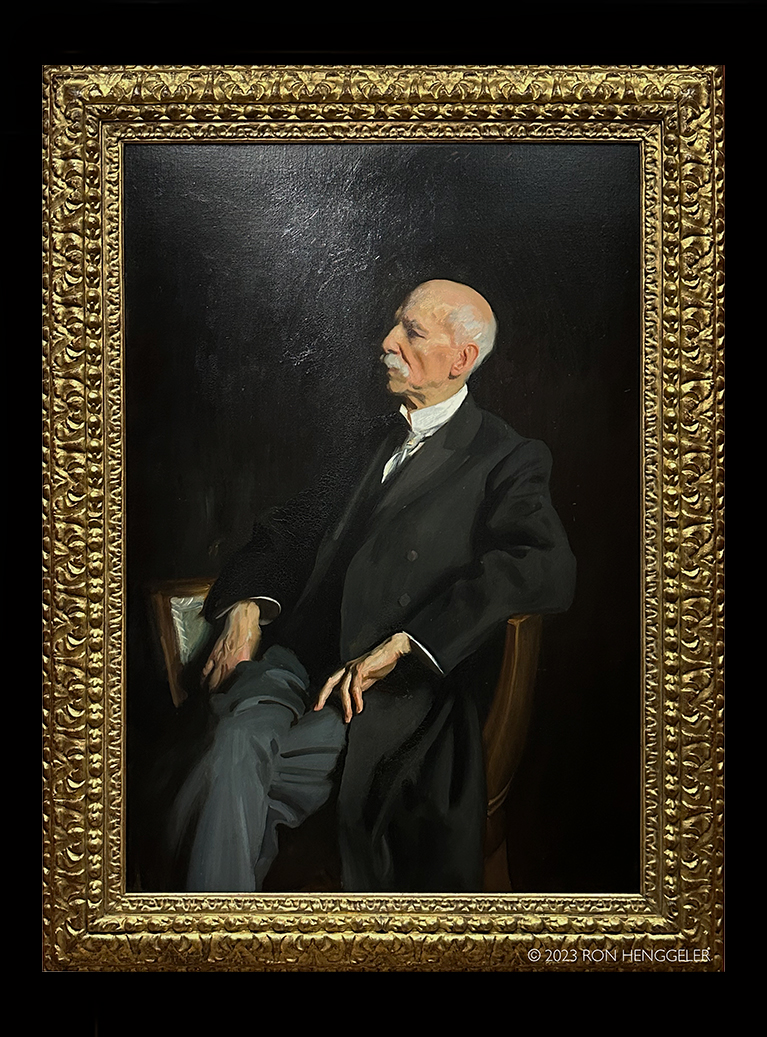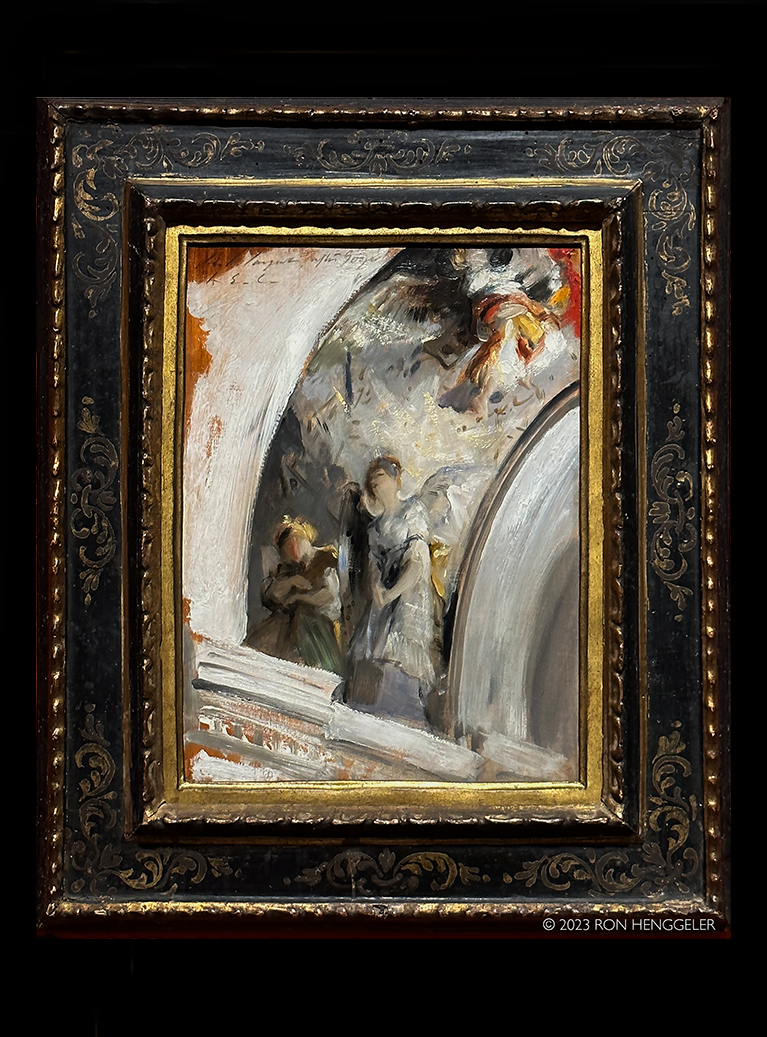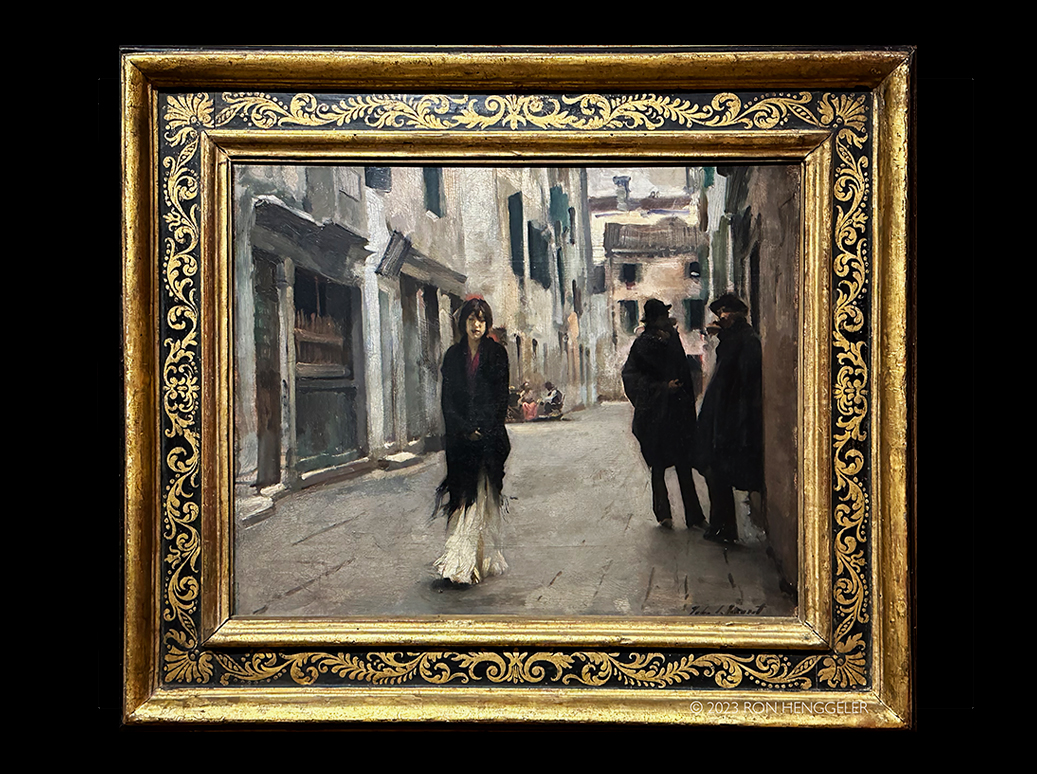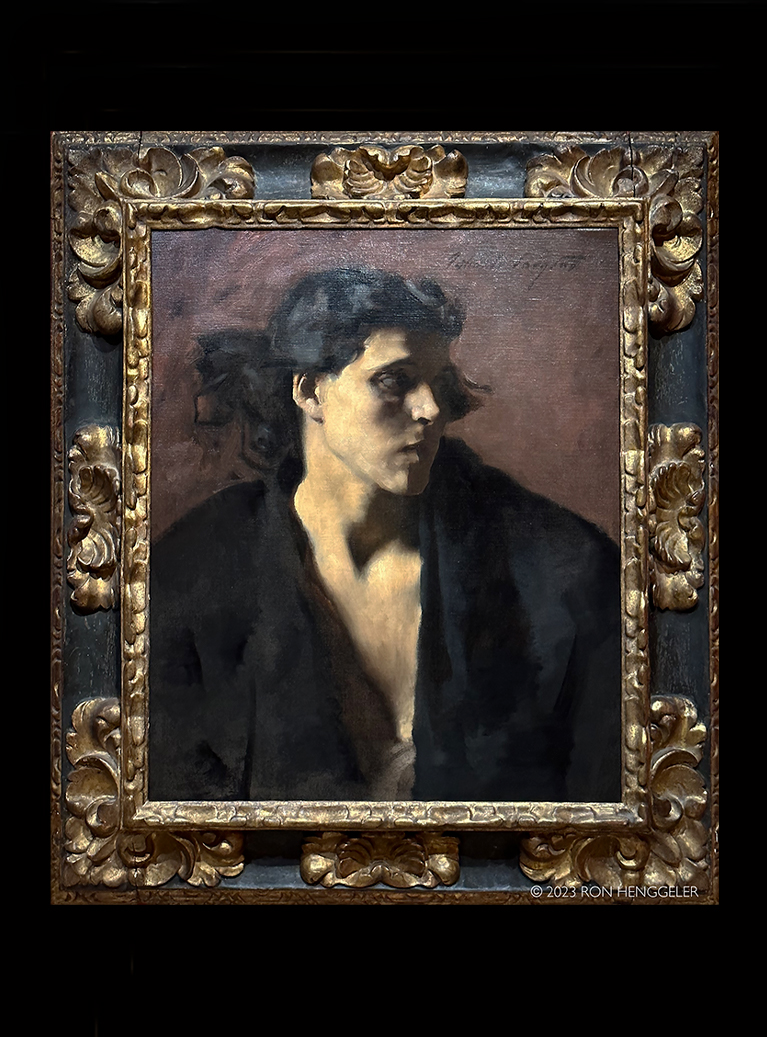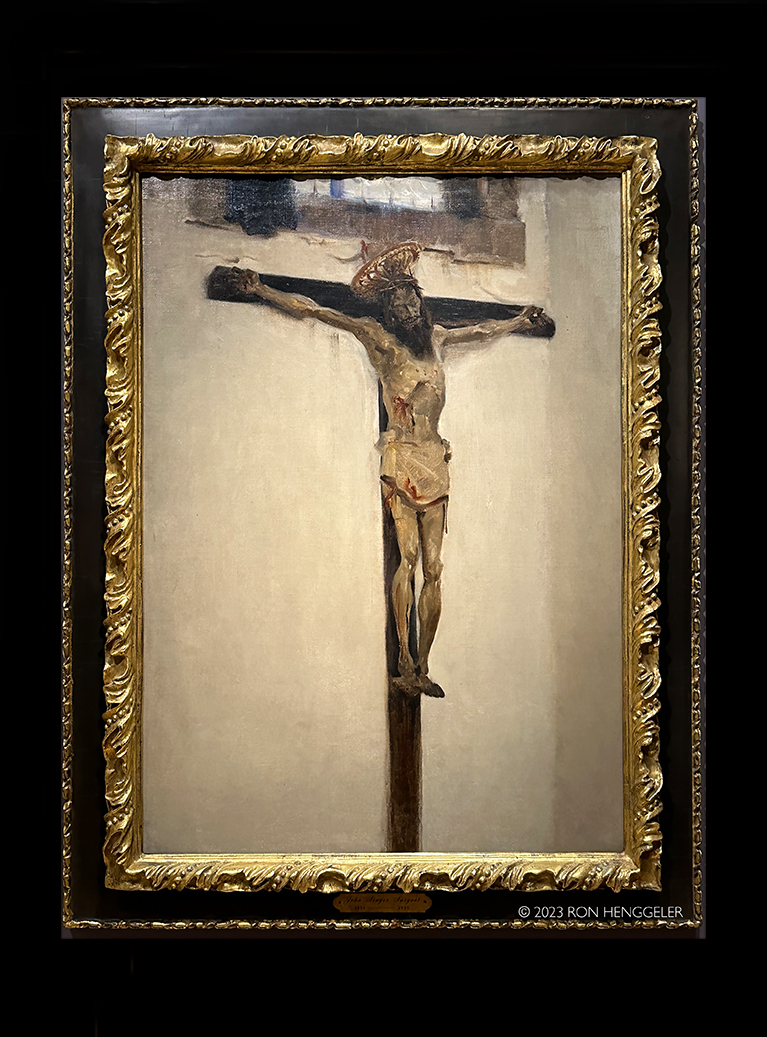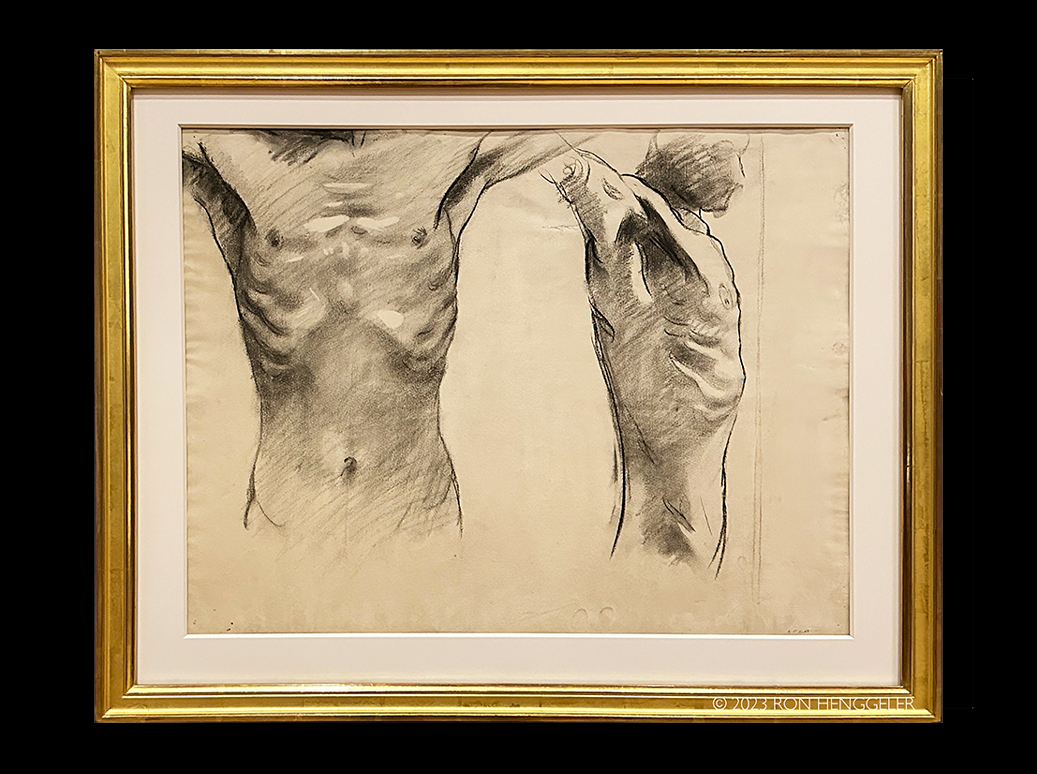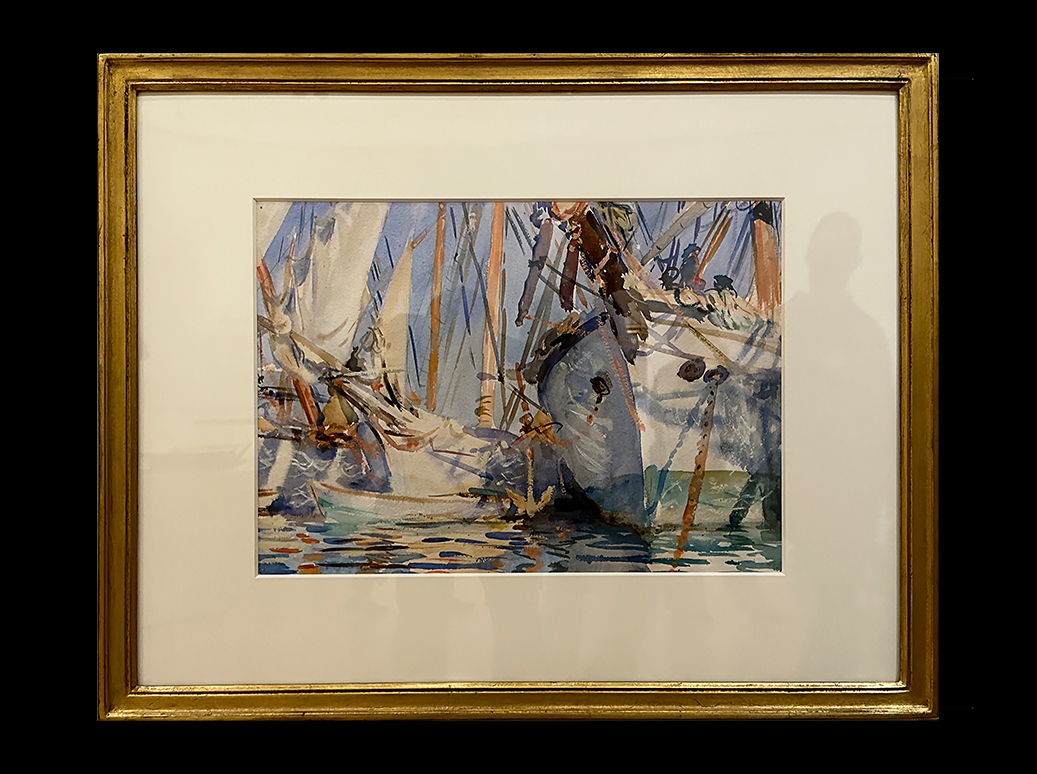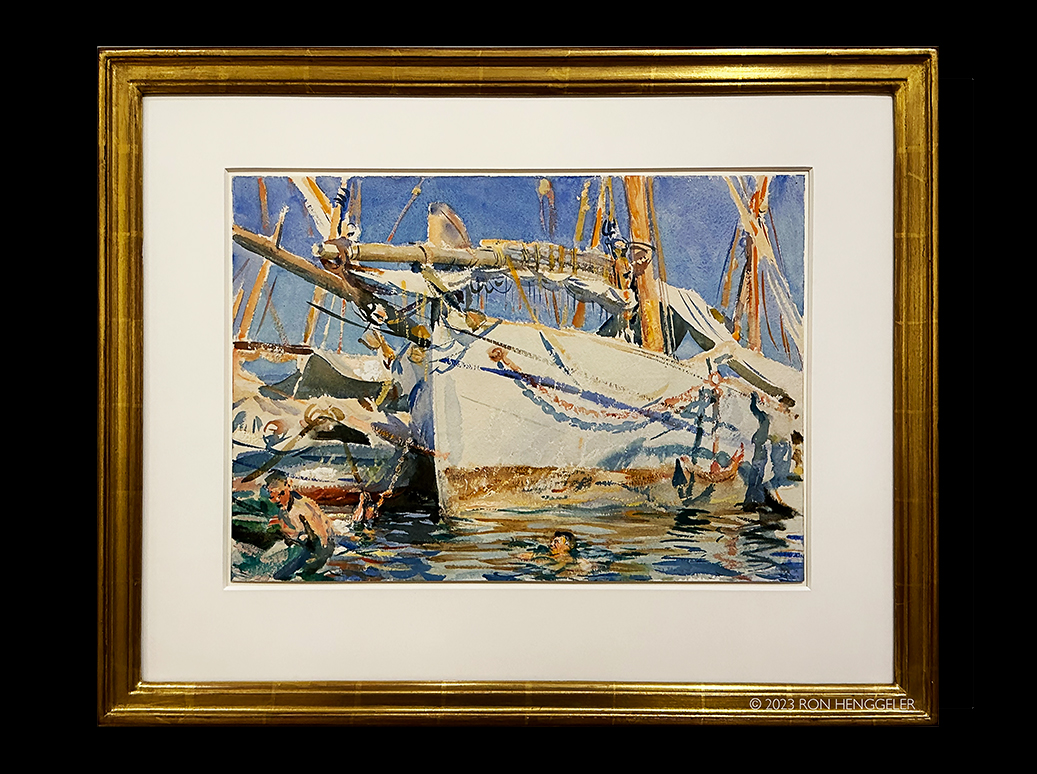| |
February 23, 2023
Sargent and Spain, at the Legion of Honor |
|
| |
John Singer Sargent's seven trips to Spain taken between 1879
and 1912, fueled his imagination and influenced his artistic growth throughout his life. Born in Florence, Italy, to American parents who were travel enthusiasts, Sargent (1856-1925) journeyed extensively in search of subjects. His resulting body of work, including pictures inspired by Spanish art, architecture, gardens, people, and traditions, encompassed far more than the society portraits which he is best known.
Sargent undertook his first adult trip to Spain at age twenty-three,
after completing artistic training in Paris. For this and subsequent visits, he would venture across oceans, national boundaries,
and unforgiving terrain to traverse the country. He embraced and
Spain's rich cultural diversity -from the metropolitan buzz of Madrid to the coastal calm of Majorca, the intricate patterns of Andalusia, and the natural beauty of the countryside. |
|
| |
Much like travelers today Sargent took photographs and bought souvenirs to help sustain memories of his journeys and spark his creativity long after he had returned to his studio. He often purchased photographs that he preserved in scrapbooks along with his pencil sketches and other sources of inspiration. He also collected Spanish art, music, and literature, as well as books about for the country's architecture and gardens. These cherished possessions, along with the works of art exhibited at the Legion, reveal his affinity for Spain and his considered approach to depicting the rich subject matter he encountered there. The country continued to inspire Sargent's art through the end of his career, reminding us of the powerful and lingering influence of travel. |
|
|
|
| |
Churches, coastlines, gardens, royal palaces, dancing — vibrant works by John Singer Sargent (1856 – 1925) immerse you in the rich culture of Spain. This exhibition, in its exclusive West coast stop, is the first to explore the influence of Spanish culture on Sargent’s dynamic visual practice. Celebrated as the society portraitist of his era, Sargent influenced a generation of American painters. His captivation with Spain, which developed over the course of seven visits taken from 1879 to 1912, resulted in a remarkable body of work. The exhibition presents an array of Sargent’s dazzling oils, watercolors, and drawings, along with never-before-exhibited photographs, showcasing Spain’s people, architecture, and magnificent urban and rural landscapes.
|
|
| |
|
|
|
| |
|
|
| |
|
|
|
| |
J. William White (American, 1850-1916), Sargent in the Court of the Lions, Alhambra, July 9, 1895, 1895. Silver print. Historical Society of Pennsylvania, Philadelphia.
Image courtesy of Historical Society of Pennsylvania |
|
| |
|
|
|
| |
Sketches of a Spanish Dancer, ca. 1880-1881
Graphite
This drawing relates to Spanish Dancer, the life-size painting of a single flamenco dancer that John Singer Sargent worked on alongside El Jaleo(1882). While the work recalls the flamenco performances he had experienced in Spain, Sargent sketched it in his Paris studio with a model, who captured the dancer's pose and the tilt of her head.
|
|
| |
|
|
|
| |
La Carmencita, 1890
Oil on canvas
Musée d'Orsay, Paris, Acquired in 1892
John Singer Sargent saw Carmen Dauset Moreno, a native of Andalusia who used the stage name La Carmencita, dance at a New York City music hall. Here, she appears as if beginning a performance, holding a confident pose that reveals her dramatic costume. The details on the vibrant dress embellished the dancer's movements, which would have animated the wide, glittering skirt and fringed bodice. Sargent completed his other major Spanish dance paintings soon after his trip to Spain in 1879. However, his encounter with La Carmencita revived his artistic interest in the spectacle of Spanish dance-so much so that he was inspired to paint this full-length portrait without a commission. |
|
| |
|
|
|
| |
Detail of: La Carmencita, 1890 |
|
| |
|
|
|
| |
Detail of: La Carmencita, 1890 |
|
| |
|
|
|
| |
Study for "The Spanish Dance," ca. 1879-1880
Oil on canvas
The Nelson-Atkins Museum of Art, Kansas City, Missouri, Gift of Julia and Humbert Tinsman, F83-49
This study for the painting The Spanish Dance reveals John Singer Sargent's exploration of variations in mood, poses, and clothing. Diverging from the palette of the finished painting, here the night sky has an eerie yellowish light that mirrors the color of the lead dancer's dress. In both works, the male dance partner in the foreground appears as a shadowy, nearly all-black form. |
|
| |
|
|
|
| |
Detail of: Study for "The Spanish Dance", ca. 1879-1880
Oil on canvas |
|
| |
|
|
|
| |
Albert de Belleroche, ca. 1882
Oil on canvas
Welsh-born artist Albert de Belleroche posed in a Spanish hat and cloak, souvenirs John Singer Sargent acquired during his 1879 trip to Spain. Sargent's bold dashes of paint and the striking red background match his friend's dramatic pose. Both Sargent and Belleroche were students of the art teacher Carolus-Duran in Paris, and at times they painted together in Sargent's studios in Paris and London. |
|
| |
|
|
|
| |
Detail of: Albert de Belleroche, ca. 1882
Oil on canvas |
|
| |
|
|
|
| |
The Studio -Spanish Dress (Study for Man and Woman on a Bed), ca. 1880-1882
Graphite
The female model in this sketch wears garments that John Singer Sargent likely bought in Spain and brought out for inspiration in the studio. The mood of this work is uneasy, as the woman's wary eyes and the man's tight grip on her forearm imply that she may be on the bed against her will. |
|
| |
|
|
|
| |
|
|
| |
|
|
|
| |
La Carmencita Dancing, 1890
Oil on canvas
Private collection
John Singer Sargent was struck by the drama and presence of the Spanish dancer known as La Carmencita, whom he met and painted in New York. He covered this canvas in vigorous paint strokes, communicating the performer's energy and mesmerizing movements as she executed intricate spins and steps. A silent film shown in the museum gallery, recorded in Thomas Edison's New Jersey studio in 1894, shows her dynamic style of dancing. The dress she wears in the film is closer in style to the golden costume in the larger portrait of her in this gallery. |
|
| |
|
|
|
| |
|
|
| |
|
|
|
| |
Pool in the Garden of La Granja, ca. 1903
Watercolor over graphite |
|
| |
|
|
|
| |
A Marble Fountain at Aranjuez, 1912?
Oil on canvas
Collection of Sharon P. and John D. Rockefeller IV
This vibrant rendering, made in the gardens surrounding the royal summer palace of Aranjuez, south of Madrid, reveals John Singer Sargent's deft treatment of sunlight and shadow. The artist cropped the sculpture of the mythological figure Triptolemus, suggesting that the viewer is passing the fountain in a fleeting moment. Highlights on the octagonal base and its sculpted scrolls, lions, and coat of arms contrast with the shadows of the recessed channels and the verdant groves beyond.
Sargent wrote of Aranjuez: The place is perfectly charming, grand gardens with Cavernous avenues and Fountains and statues, long neglected-good natured friendly people - lunch in the open air under arbours of roses." He also enjoyed the gardens of other summer palaces. |
|
| |
|
|
|
| |
Detail of: A Marble Fountain at Aranjuez, 1912?
Oil on canvas |
|
| |
|
|
|
| |
Alhambra, Patio de los Leones (Court of the Lions), 1895
Oil on canvas
Collection of Stevenson Scott Kaminer
For his final oil of the Alhambra palace, John Singer Sargent depicted the east portico of the Court of the Lions, named for the stone sculptures surrounding the enclosure's fountain. His rendering of the golden light on the delicate columns, filigree walls, and arcades contrasts with the dark recesses, which lead to the multiple chambers of the magnificent Hall of the Kings. A diary kept by Sargent's 1895 travel companion and recently discovered photographs by him have revealed rare specificity of detail: the artist began the painting on the afternoon of July 7,1895, and worked on it for several days thereafter.
|
|
| |
|
|
|
| |
Alhambra, Patio de los Arrayanes (Court of the Myrtles), 1879
Oil on canvas
Private collection
John Singer Sargent's earliest oil of the Alhambra, an extensive palace complex built by the Muslim Nasrid dynasty, shows a glowing view of the Court of the Myrtles, one of the palace's most famous attractions.
The artist chose an off-center view of the courtyard, focusing on the narrow central pool and its reflection of the sun-drenched facade. He treated only the central bay of the arcade in a detailed manner, enticing the viewer with a dark recession of spaces.
In most other areas of the painting, the elements seem blurred by the searing Mediterranean heat.
|
|
| |
|
|
|
| |
|
|
| |
|
|
|
| |
Courtyard, Casa del Chapiz, 1912-1918
Oil on canvas
Myron Kunin Collection of American Art
John Singer Sargent was as interested in Granada's residential neighborhoods as he was in the elaborately decorated and landscaped complexes of the Alhambra and Generalife -two palatial estates of the Muslim Nasrid dynasty, which ruled Granada from 1230 to 1492. In this depiction of a courtyard of the sixteenth-century Casa del Chapiz, the artist carefully but economically defined details such as the elaborately carved capitals supporting the balconies.
When Sargent encountered this courtyard, the architecturally significant residence had fallen into a state of ruin. Accordingly, his rendering conveys a feeling of quiet disuse: the airy enclosure is empty save for resting pack mules, tilting water basins, and a few scattered tools and baskets. Earlier, Sargent fluidly rendered the building's architectural details in Turkey in a Courtyard. |
|
| |
|
|
|
| |
Detail of: Courtyard, Casa del Chapiz, 1912-1918
Oil on canvas |
|
| |
|
|
|
| |
Well Head with Kufic Inscription, ca. 1879
Watercolor over graphite
Private collection
John Singer Sargent encountered this fourteenth-century wellhead in Toledo's archaeological museum. These protective covers for well openings offered sculptors opportunities for elaborate embellishments. Sargent delighted in the contrast between the matte, lightly hued body of the glazed ceramic cylinder and the interlocking patterns of its teal sash. The band comprises braids, knots, leaves, and Kufic characters- an ancient Arabic script-which repeat the phrase "happiness is for God." The young artist studied the vessel's details closely, including its damaged rim and the plaster or paper mending material. |
|
| |
|
|
|
| |
Turkey in a Courtyard, ca. 1879-1880
Oil on panel |
|
| |
|
|
|
| |
Women at Work, ca. 1912
Oil on canvas |
|
| |
|
|
|
| |
Detail of: Women at Work, ca. 1912
Oil on canvas |
|
| |
|
|
|
| |
Spanish Roma Woman, ca. 1879-1882
Oil on canvas
The Metropolitan Museum of Art, New York, Gift of George A. Hearn,
1910, 10.64.10
This portrayal of a brightly robed woman whose serene face emerges from a dark background differs dramatically from John Singer Sargent's depictions of lively Andalusian dancers on view earlier in the exhibition. Sargent maintained a sympathetic approach to the Spanish Roma that was atypical for the era, when many perceived them to be outsiders or on the margins of society. They often were exoticized as «picturesque" flamenco dancers and fortune-tellers, or considered to be nomadic criminals stereotypes that persist today.
The below text was written by advisory group member Cristiana Grigore, writer, research scholar, and founder of the Roma Peoples Project, Columbia University, New York:
There is something in her expression -not quite happy or sad, perhaps lost in thought, burdened, or just tired -that I have seen before in other Roma women. These complex facial expressions are hard to comprehend and suggest so many untold stories.
What I find refreshing in this portrait is the woman's humanity, which contrasts with the idealized rendering of dancer and seductress that appear in so many other portrayals of Roma women. By bringing such an image to the forefront of art, we can start not only to question who this particular Roma woman was, but also to consider the diversity of all Roma women. We, the Roma women, have stood in the shadows for too long. It's time for our beauty, talents, and stories to be acknowledged with dignity and agency. Perhaps one day a Roma girl will walk into a museum, see a variety of representations of real-life and inspiring Roma women, and be able to say,"I, too, belong." |
|
| |
|
|
|
| |
Hospital at Granada, 1912
Oil on canvas
National Gallery of Victoria, Melbourne, Felton Bequest, 1924, 1337-3
While hospitals are not considered tourist destinations today, popular guidebooks in John Singer Sargent's era extolled the art and architecture of significant Renaissance buildings such as the sixteenth-century Hospital of Saint John of God in Granada. The sun- and shadow-filled loggia, with its graceful arches, paintings, and hint of the courtyard below, serves as a dissonant backdrop for the injured figures. One critic noted of the painting that the convalescing patients depicted were experiencing
"deep notes of joy and despair." |
|
| |
|
|
|
| |
Detail of: Hospital at Granada, 1912
Oil on canvas |
|
| |
|
|
|
| |
Stable at Cuenca, ca. 1903
Oil on canvas |
|
| |
|
|
|
| |
Detail of: Stable at Cuenca, ca. 1903
Oil on canvas |
|
| |
|
|
|
| |
|
|
| |
|
|
|
| |
|
|
| |
|
|
|
| |
Mosquito Nets, 1908
Oil on canvas
Detroit Institute of Arts, Founders Society Purchase
John Singer Sargent depicted his sister Emily and their friend Eliza Wedgwood enjoying a leisurely moment at their rented villa in the mountain village of Valldemosa. The trio were passionate readers;
Eliza later recalled that "we all took books with us, but John's library was always the biggest." She also reminisced that Emily had devised their mosquito netting. On view nearby are Sargent's watercolors of his traveling companions outdoors, including one of Emily concentrating intently on painting. |
|
| |
|
|
|
| |
Detail of: Mosquito Nets, 1908
Oil on canvas |
|
| |
|
|
|
| |
Eliza Wedgwood, ca. 1908-1909
Watercolor over graphite |
|
| |
|
|
|
| |
Majorcan Fisherman, 1908
Oil on canvas
Private collection
Vibrant color and brushwork describe this young fisherman, who confronts viewers with a direct gaze and self-assured pose. The sun-drenched scene is an explosion of patterned lights and darks: isolated areas, such as the ground at right, appear as nearly abstract mosaics, in contrast with the swaths of blue defining sea and sky. This patterning recalls John Singer Sargent's shipping scenes on view nearby.
Made just a few months earlier at the port of Palma, their crisscrossing masts and lines balance the sun's dazzling reflections on the water. |
|
| |
|
|
|
| |
Detail of: Majorcan Fisherman, 1908
Oil on canvas |
|
| |
|
|
|
| |
Horses at Palma, Majorca, 1908
Oil on canvas |
|
| |
|
|
|
| |
Detail of: Horses at Palma, Majorca, 1908
Oil on canvas |
|
| |
|
|
|
| |
Under the Olives, 1908
Oil on canvas
Cedarhurst Center for the Arts, Mount Vernon, Illinois, Gift of John R. and Eleanor R. Mitchell, 1973.1.54
John Singer Sargent was captivated by the agricultural traditions of the fertile Majorcan countryside. In Under the Olives, two girls tend to a herd of Iberian black pigs surrounded by the twisted trunks of olive trees. The same models appear in Gathering Blossoms, filling their baskets with ripened fruit from the large fig tree whose roots spill over a dry stone wall. The two scenes are characterized by somewhat disorienting vantage points, as well as by tapestry-like surfaces comprising dashes and daubs of brilliant paint. |
|
| |
|
|
|
| |
Detail of: Under the Olives, 1908
Oil on canvas |
|
| |
|
|
|
| |
Gathering Blossoms, Valldemosa, Majorca, 1908
Oil on canvas |
|
| |
|
|
|
| |
Pomegranates, Majorca, 1908
Oil on canvas
Collection of Nancy and Sean Cotton
This patchwork of fruit, leaves, and tree roots envelops the viewer. The unusual angle and cropping suggests John Singer Sargent's avid interest in photography and also his close study of the island's vegetation in preparation for painting the details of his murals at the Boston Public Library. |
|
| |
|
|
|
| |
Detail of: Pomegranates, Majorca, 1908
Oil on canvas |
|
| |
|
|
|
| |
Study of a Fig Tree, 1908
Oil on canvas
McMullen Museum of Art, Boston College, Carolyn A. and Peter S. Lynch Collection, 2022.18
Around the time he visited Majorca in 1908, John Singer Sargent was working on the Messianic Era segment of his Boston Public Library Triumph of Religion murals (discussed in the next gallery). In this lunette, he depicted a young Christ stepping into a new paradise against a decorative backdrop of fruit and foliage. Here, Sargent delineates the contours of the intertwining leaves in preparation for the mural. Symbolizing renewal and redemption, the pomegranates Sargent observed in Majorca also form the basis for the decorative imagery of Messianic Era.
Conveying the island's natural lushness, Sargent's studies of vegetation express his long-standing interest in pattern and decoration. In these tightly focused and cropped compositions, he presents the fruits as an abstracted, sensuous, and impressionistic study of light, texture, and surface. |
|
| |
|
|
|
| |
Pomegranates, Majorca, 1908
Oil on canvas
Private collection
John Singer Sargent achieved an almost decorative effect by magnifying a section of a pomegranate tree-such as the one depicted in a related painting nearby-and isolating it from surrounding vegetation and sky. The ripe, succulent fruits are pushed forward as if for viewers' enjoyment. This is a radical painting that defies categorization, blurring the line between landscape and still life. |
|
| |
|
|
|
| |
Detail of: Pomegranates, Majorca, 1908
Oil on canvas |
|
| |
|
|
|
| |
Pomegranates, 1908
Watercolor over graphite, with gouache |
|
| |
|
|
|
| |
Detail of: Pomegranates, 1908
Watercolor over graphite, with gouache |
|
| |
|
|
|
| |
|
|
| |
|
|
|
| |
Tarragona, ca. 1908
Watercolor over graphite, with gouache on paper mounted on board
New Britain Museum of American Art, Connecticut, Grace Judd Landers Fund, 1944.02
This study features seven of the statues of apostles and prophets adorning the entrance portal to the cathedral of Tarragona, located in the northeastern region of Catalonia. John Singer Sargent typically painted architectural fragments rather than entire structures. Here, he isolated a particular portion of the huge physical edifice, concentrating on light falling on decorative, figural detail. |
|
| |
|
|
|
| |
In a Church at Granada, ca. 1895
Watercolor over graphite, with brown wash
High Museum of Art, Atlanta, Gift of Mr. and Mrs. Charles O. Smith, Jr.,
1991.311
This watercolor demonstrates John Singer Sargent's preoccupation with the mysticism of Spanish Catholic religious imagery and his interest in architectural and sculptural detail. The relief of Saint Bruno of Cologne reaching heavenward is part of the massive, visually complex altar of the Renaissance church of San Jerónimo in Granada.
Here, Sargent isolated just one of the figures within its intricate niche, creating an intimate religious moment. Sargent made two more watercolors of the church's reliefs, including Saint with Dragon (ca. 1895), presented on this wall. |
|
| |
|
|
|
| |
Astarte, ca. 1890-1895
Oil on canvas
The Metropolitan Museum of Art, New York, Gift of Mrs. Francis Ormond, 1950, 50.130.3
Astarte-an ancient fertility goddess of both the Canaanite and the Phoenician pantheons, derived from an earlier Syrian deity- is one of the figures representing pagan deities that dominate the north ceiling vault of John Singer Sargent's mural cycle in the Boston Public Library. Both Astarte and the Virgin of the Immaculate Conception, whose cult was very popular in Spain, shared the moon as an attribute, but Sargent changed its position from near the goddess's head to beneath her feet. He also depicted the figure in celestial blue and with a sun behind her head like a halo, effectively creating a pagan counterpart to the Virgin. |
|
| |
|
|
|
| |
St. Teresa of Ávila, ca. 1903
Watercolor over graphite
Harvard Art Museums / Fogg Museum, Cambridge, Massachusetts, Gift of Mrs. Francis Ormond, 1937.8.67
This watercolor represents the statue of Saint Teresa by Gregorio Fernández, found in a niche in the convent in Ávila named for her. Each year, on the saint's festival day of October 15, the statue is carried out of the convent's church and through the historical quarter of the town. None of John Singer Sargent's visits to Spain coincided with the procession, so this is likely an imagined scene based on the actual statue and stories he had heard about the ritual. The artist expanded Saint Teresa's halo to create an outsize golden aura radiating around her head, lending the work a mystical dimension. |
|
| |
|
|
|
| |
Virgin and Saints, ca. 1895
Watercolor over graphite, with gouache
Private collection
John Singer Sargent probably painted this sculpture of Mary, with seven swords piercing her heart to represent the seven sorrows of her life, in southern Spain. Seven Sorrows imagery influenced the artist's Madonna of Sorrows painting at the Boston Public Library. The candles arranged before Mary and the architectural framing recall the elaborate presentations of sculptures for processions on Catholic feast days, such as those during Holy Week. While Sargent is not known to have observed such rituals, examples in his photographic collection, on view in the museum gallery, demonstrate his strong interest in them. |
|
| |
|
|
|
| |
Sierra Nevada, 1912
Oil on canvas
Collection of Barty Smith
Panoramic landscapes like this view of the snow-capped Sierra Nevada range to the southeast of Granada were rare for John Singer Sargent. He generally favored more selective depictions of the world around him, such as the nearby tree-filled watercolor revealing the same peaks. For this oil, Sargent selected an elevated vantage point in a cemetery adjacent to the Alhambra complex. He recognized the picturesque potential of the scene in late day, when the sunlight rakes across the rolling hills of the fertile Genil River valley.
|
|
| |
|
|
|
| |
Detail of: Sierra Nevada, 1912
Oil on canvas |
|
| |
|
|
|
| |
|
|
| |
|
|
|
| |
Blind Musicians, 1912
Watercolor over graphite |
|
| |
|
|
|
| |
Group of Spanish Convalescent Soldiers, ca. 1903
Watercolor over graphite, with gouache
Private collection
These two watercolors depict soldiers at the Royal Hospital in Santiago de Compostela. This city in far northwestern Spain is an important Catholic pilgrimage destination, containing the alleged burial site of the Biblical apostle Saint James. John Singer Sargent encountered the men, seen either convalescing or working in the luminous courtyard, during his 1903 visit to the hospital. Their distinctive red pants, hats, and espadrilles identify them as infantry from the Garrison of Galicia, named for the verdant coastal region surrounding the city. The adjacent oil painting of patients at the Hospital of Saint John of God in Granada recalls this earlier visit to the north. |
|
| |
|
|
|
| |
Spanish Soldiers, ca. 1903
Watercolor over graphite, with gouache |
|
| |
|
|
|
| |
|
|
| |
|
|
|
| |
Figure of Apallo from "The Forge of Vulcan", after Velazquez, 1879
Oil on canvas on board |
|
| |
|
|
|
| |
Cecil Harrison, ca. 1888
Oil on canvas
Southampton City Art Gallery, UK, SOTAG: 485
The composition of this portrait of a young boy, a simple silhouette against a shallow background, derives from Diego Velázquez. The Spanish artist's influence on John Singer Sargent is also evident in the way the light from the right falls on the boy's face and hands, which stand out against the dark setting. His sailor suit features red chevrons on the left sleeve, fashioned after the Royal Navy's use of the stripes to indicate good conduct. Cecil Harrison, the son of two of Sargent's earliest patrons, would become a major in the British Army. |
|
| |
|
|
|
| |
Manuel García, 1904-1905
Oil on canvas
Museum of Art, Rhode Island School of Design, Providence, 19.141
John Singer Sargent received the commission for this formal portrait of the renowned Spanish baritone singer and teacher Manuel García
(1805-1906) to mark his one hundredth birthday.
The sitter's severe but dignified pose and the painting's saturated dark palette and understated composition-made a quarter century after Sargent first journeyed to Madrid to study Spanish art-evoke aspects of Diego Velázquez's technique and confirm his lasting impact on Sargent. |
|
| |
|
|
|
| |
Angels in a Transept, Study after Goya,
1879 Oil on panel |
|
| |
|
|
|
| |
Street in Venice, 1882
Oil on wood
National Gallery of Art, Washington, DC, Gift of the Avalon Foundation,
1962.4.1
John Singer Sargent's original compositions, such as Street in Venice, which he painted a few years after his 1879 visit to Spain, reveal the influence of Diego Velázquez's distinctive palette and brushwork. In particular, the architectonic qualities, spatial recession, and strong contrast of light and dark recall similar compositional elements of the seventeenth-century Spanish artist's masterpiece, Las Meninas (1656). |
|
| |
|
|
|
| |
A Spanish Woman, 1879-1880
Oil on canvas |
|
| |
|
|
|
| |
Sketch of a Spanish Crucifix, ca. 1879
Oil on canvas
Presented by Art Fund to the Zurbarán Trust to mark the reopening of Auckland Castle in Bishop Auckland, England 2019
This crucifix has not yet been identified, but its location is probably southern Spain. The devotional sculpture emphasizes the emaciated body of the crucified Christ, a physically stark and doleful image characteristic of the darker aspects of Spanish religious iconography. The motif of the Crucifixion-especially as seen in Spanish art -was of great importance to John Singer Sargent. This is evident from the photographs he collected, some of which are on view in the case in this gallery, and by the sculptural Crucifixion that features in his murals at the Boston Public Library. |
|
| |
|
|
|
| |
Sketch for the Sorrowful Mysteries, the Crucifixion-Torso
(Boston Public Library Murals), 1903-1916
Charcoal
Museum of Fine Arts, Boston, The Sargent Collection--Gift of Miss Emily Sargent and Mrs. Violet Ormond in memory of their brother, John Singer Sargent, 28.603 |
|
| |
|
|
|
| |
White Ships, 1908
Watercolor over graphite, with gouache and wax resist |
|
| |
|
|
|
| |
A Falucho, 1908
Watercolor and gouache over graphite
Cincinnati Art Museum, Bequest of Mary Hanna, 1956.100
John Singer Sargent had a lifelong interest in ships and shipping. On his summer trip to Majorca, he painted this work and the watercolor White Ships (above), which depicts the busy port of Palma. In A Falucho, shimmering sunlight plays off the water and casts brilliant reflections on the white-painted hulls of the ships and schooners. The artist's accurate drawing of the armature of masts and rigging confirms that these are not mere painted ships upon a painted sea but working vessels responsible for the trade on which the city depended. |
|
| |
|
|
|
| |
|
|
